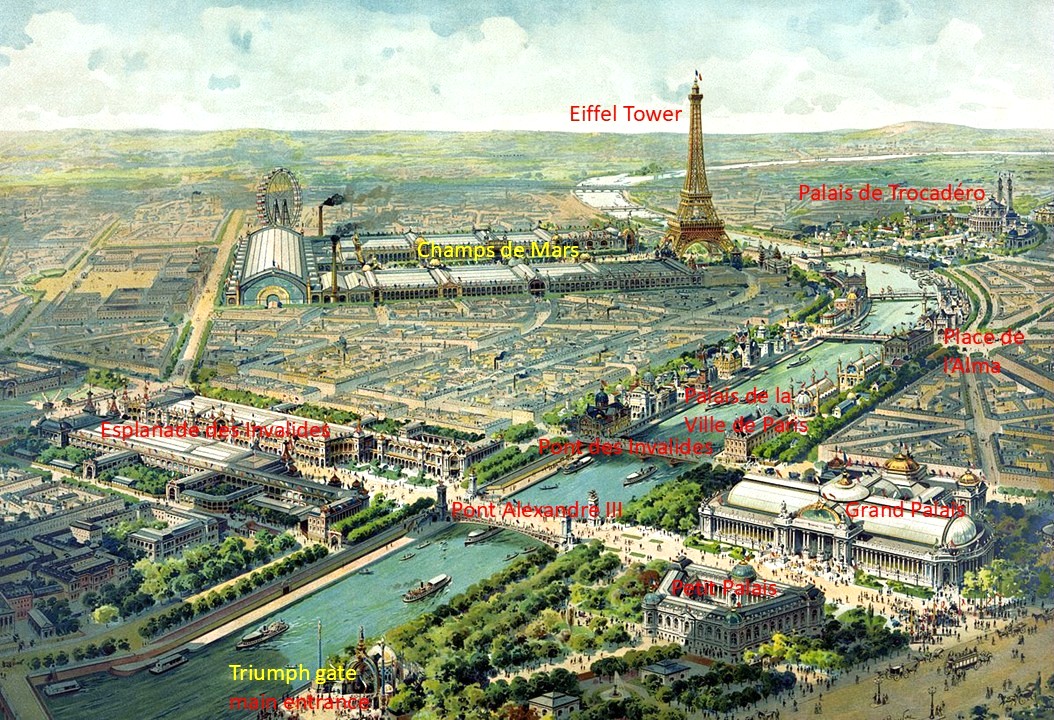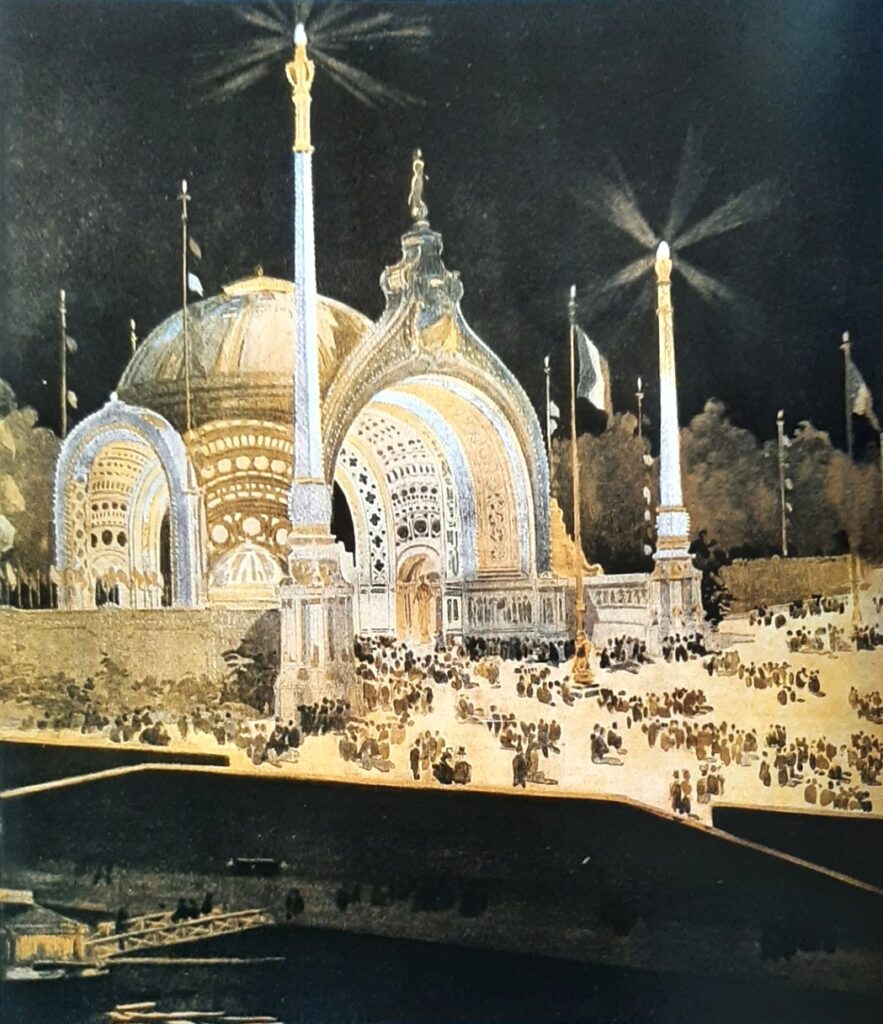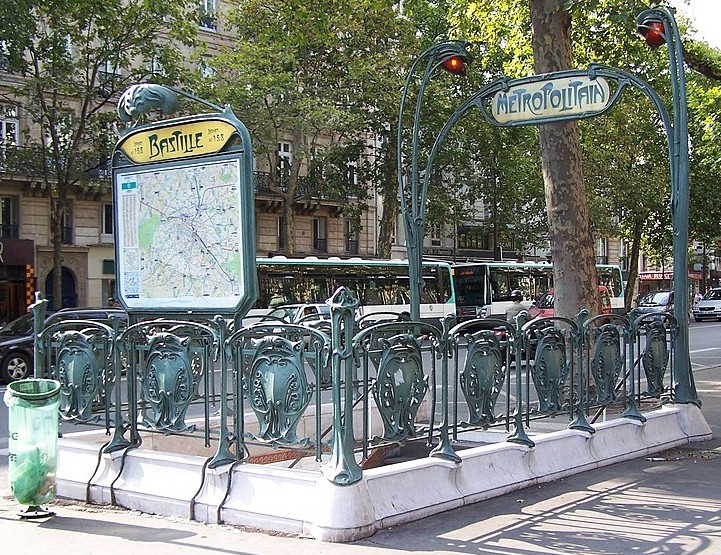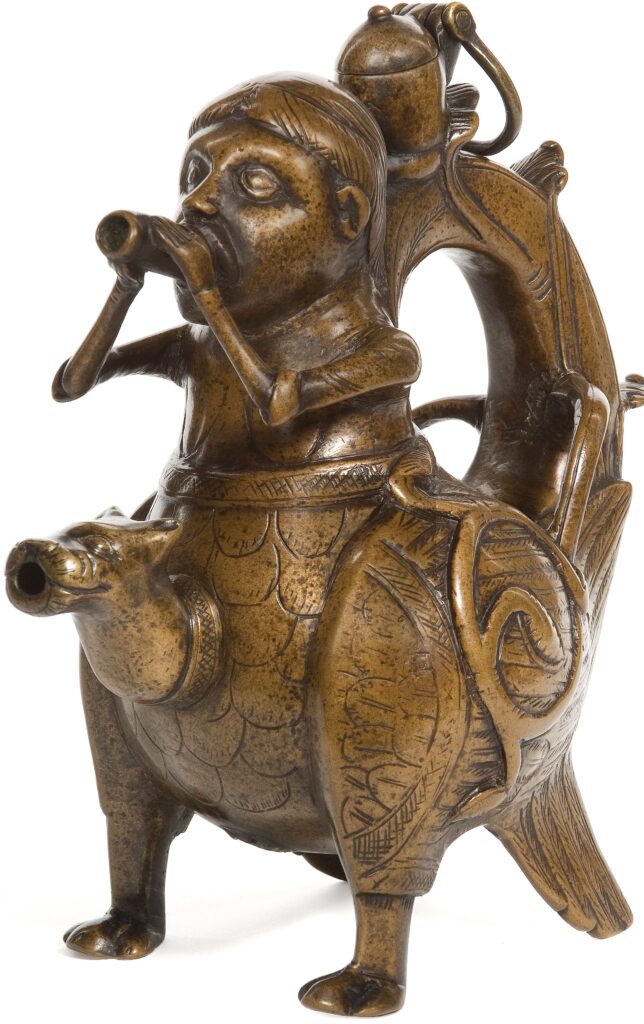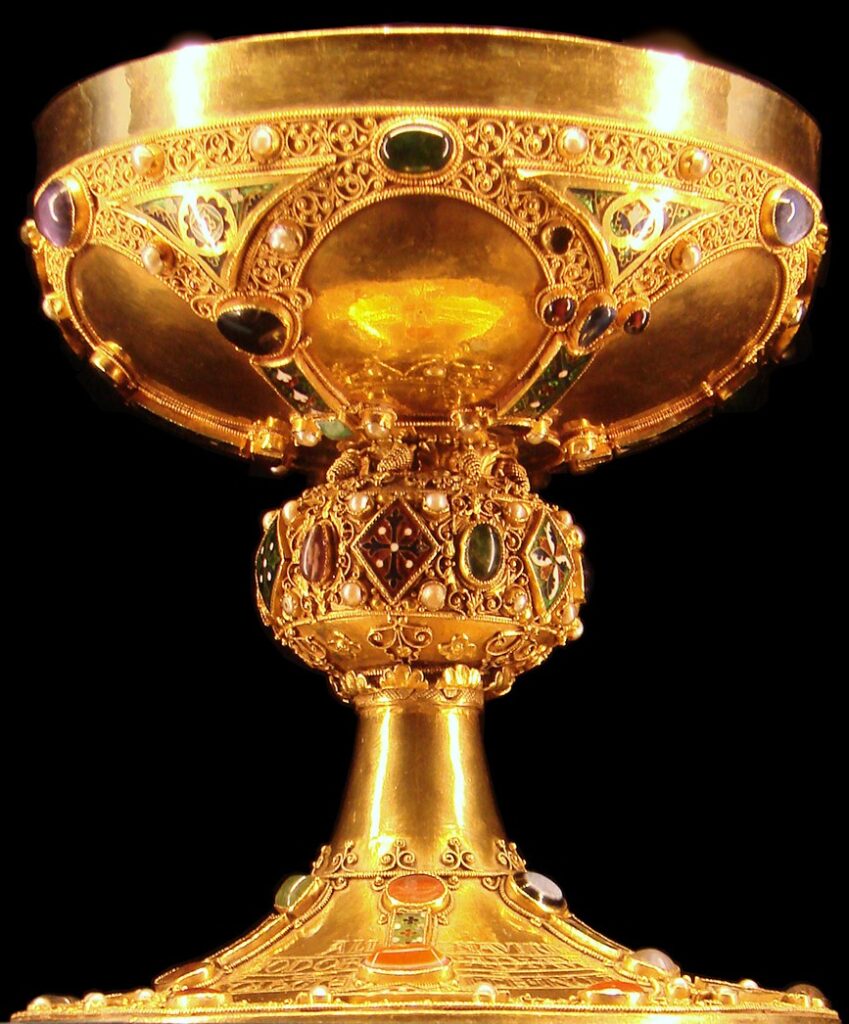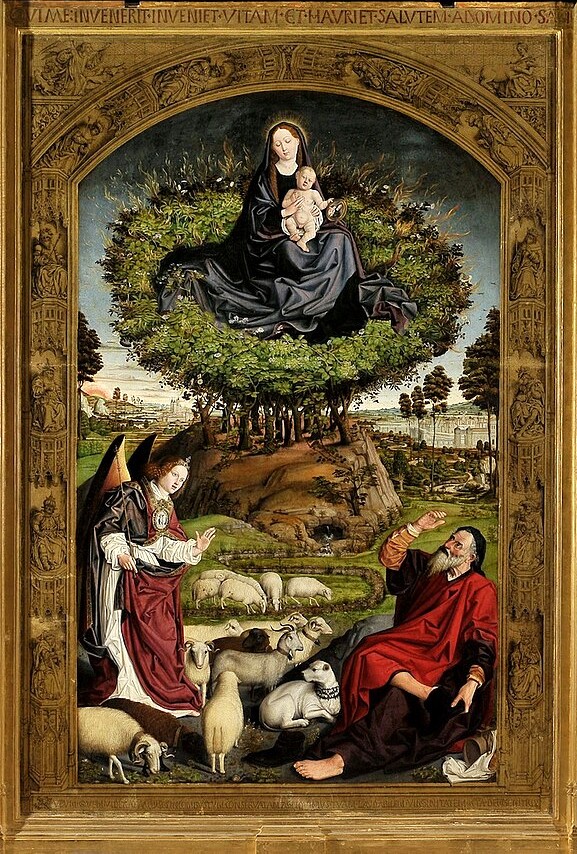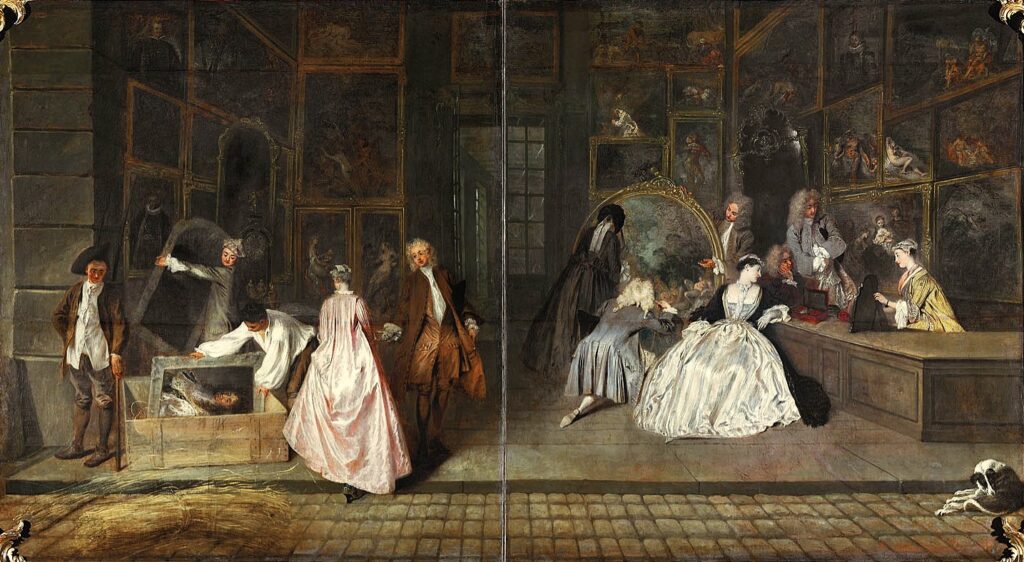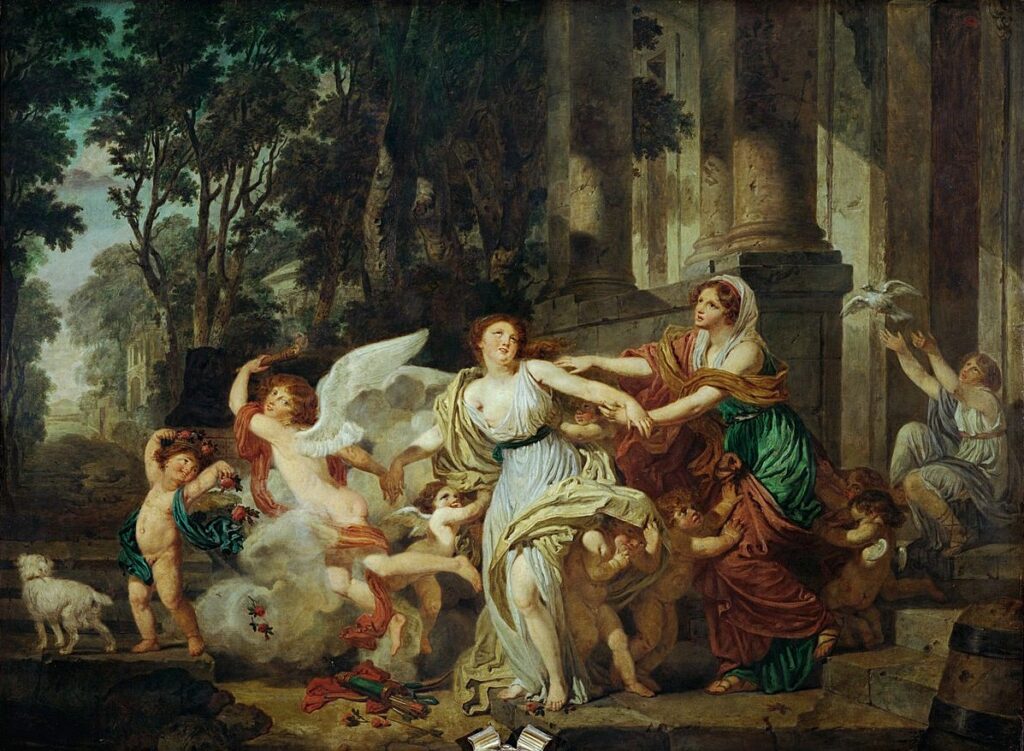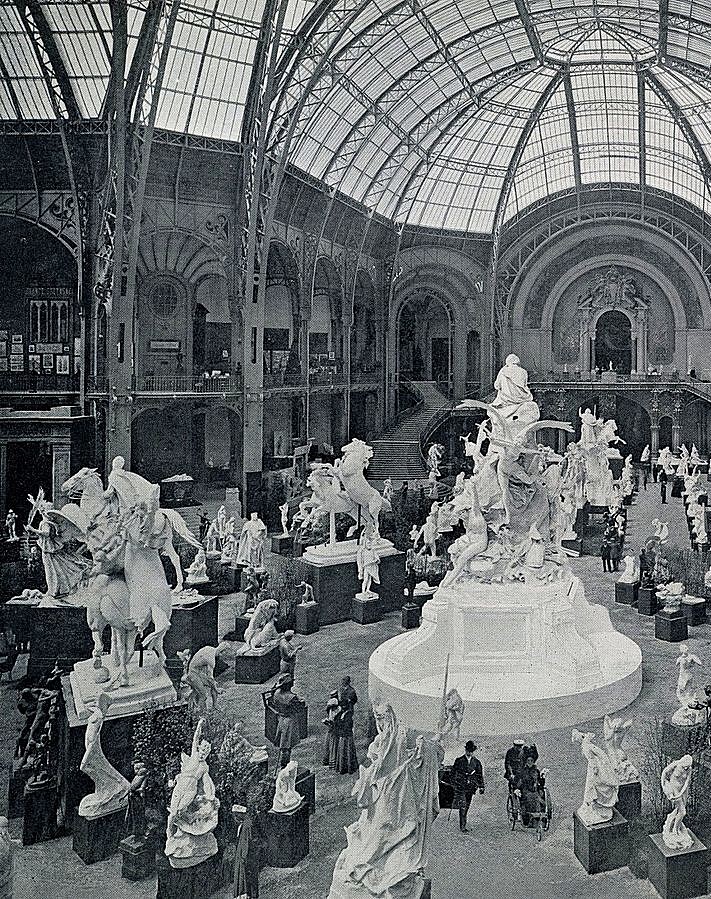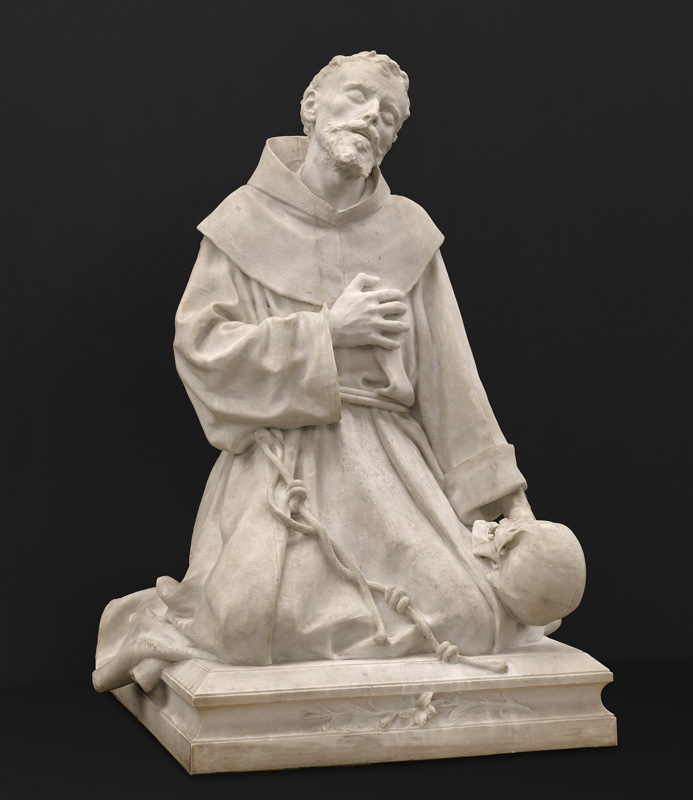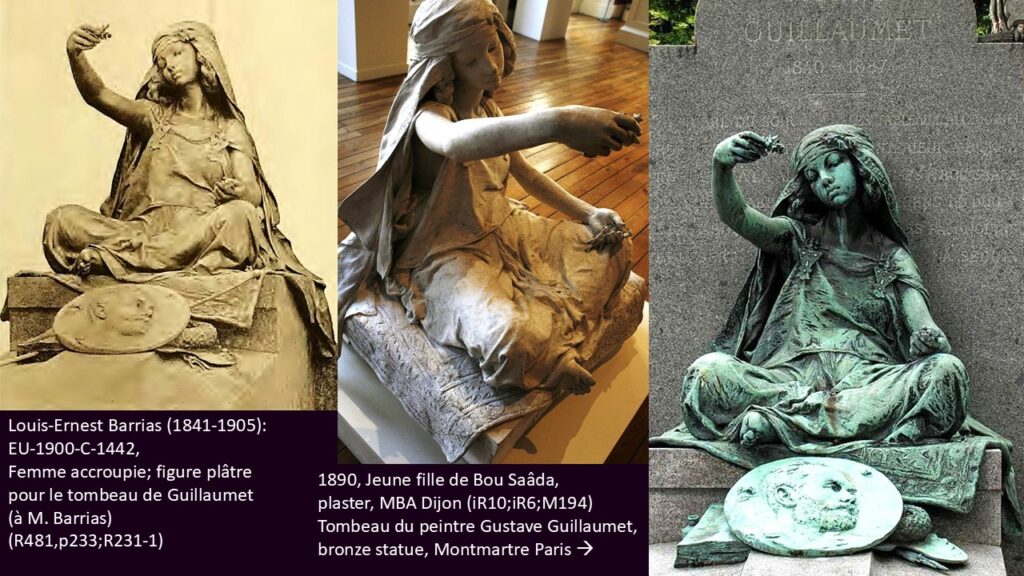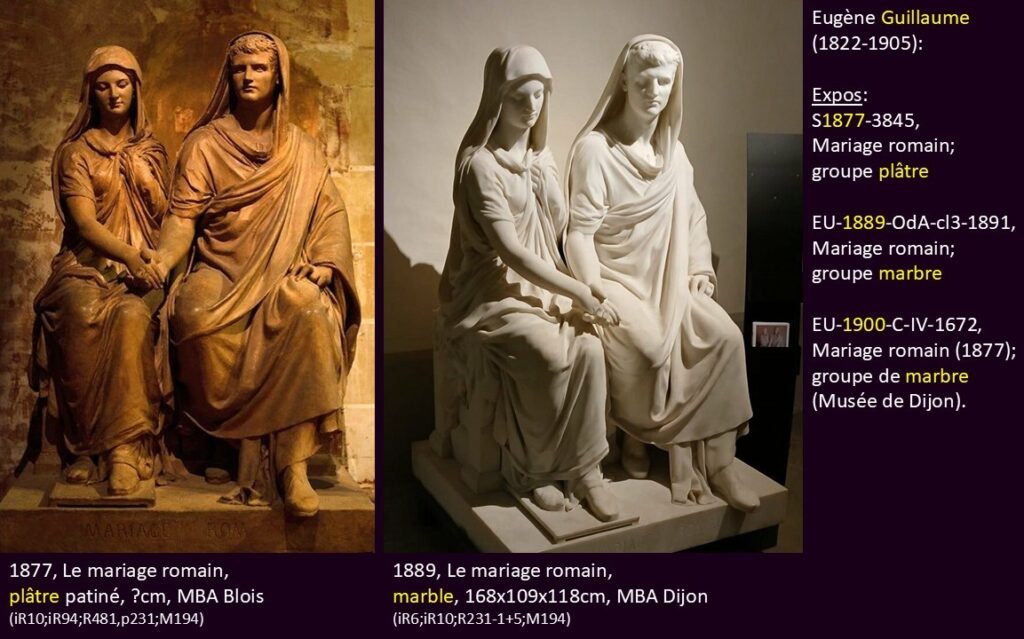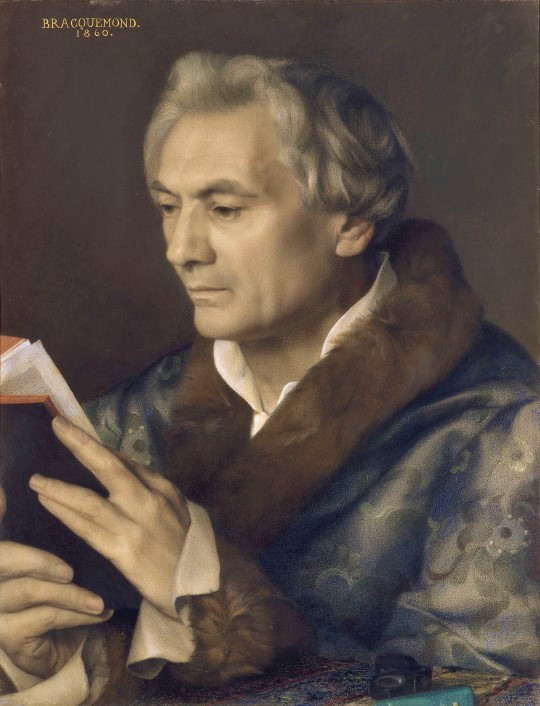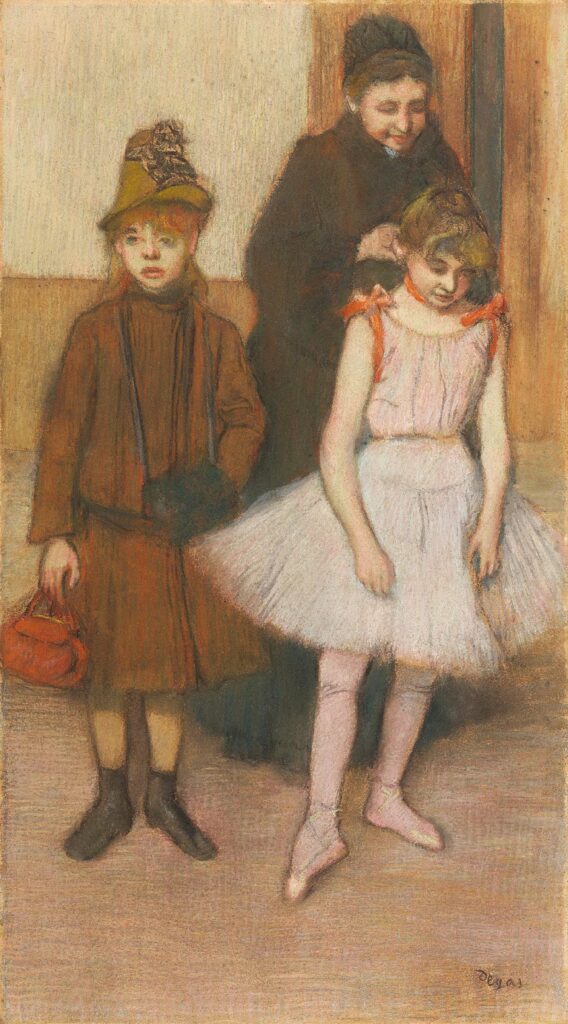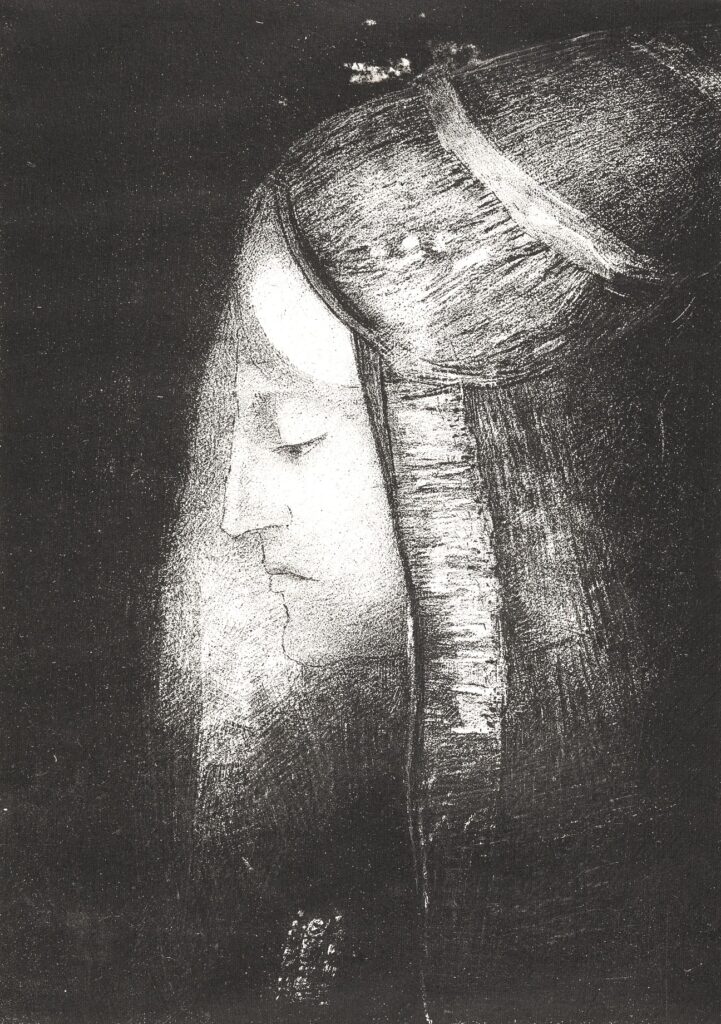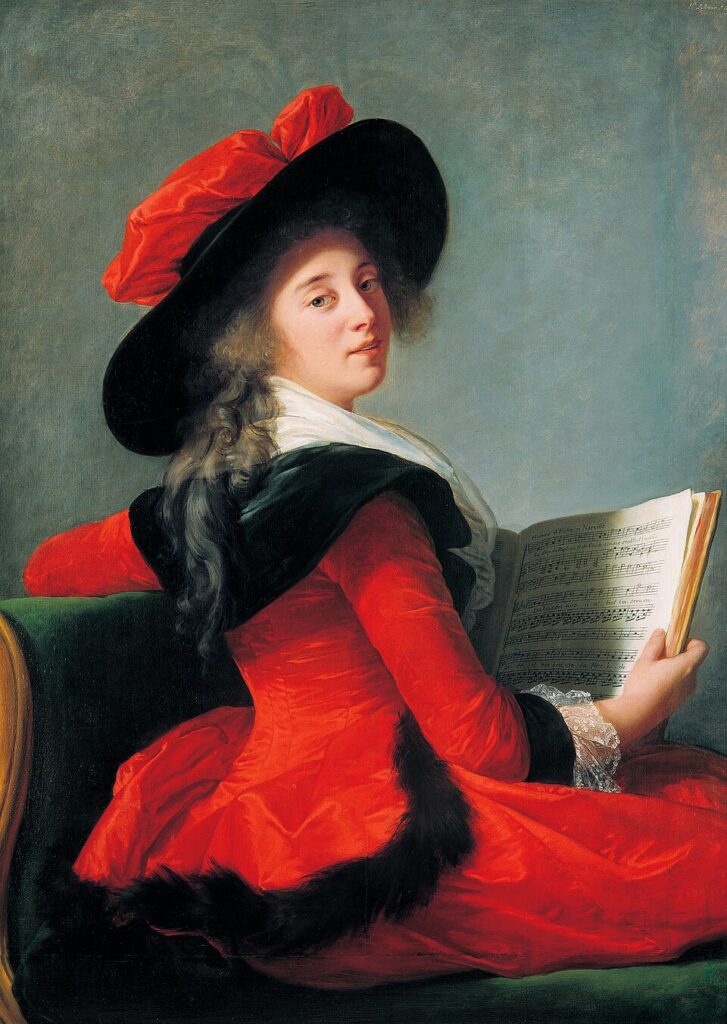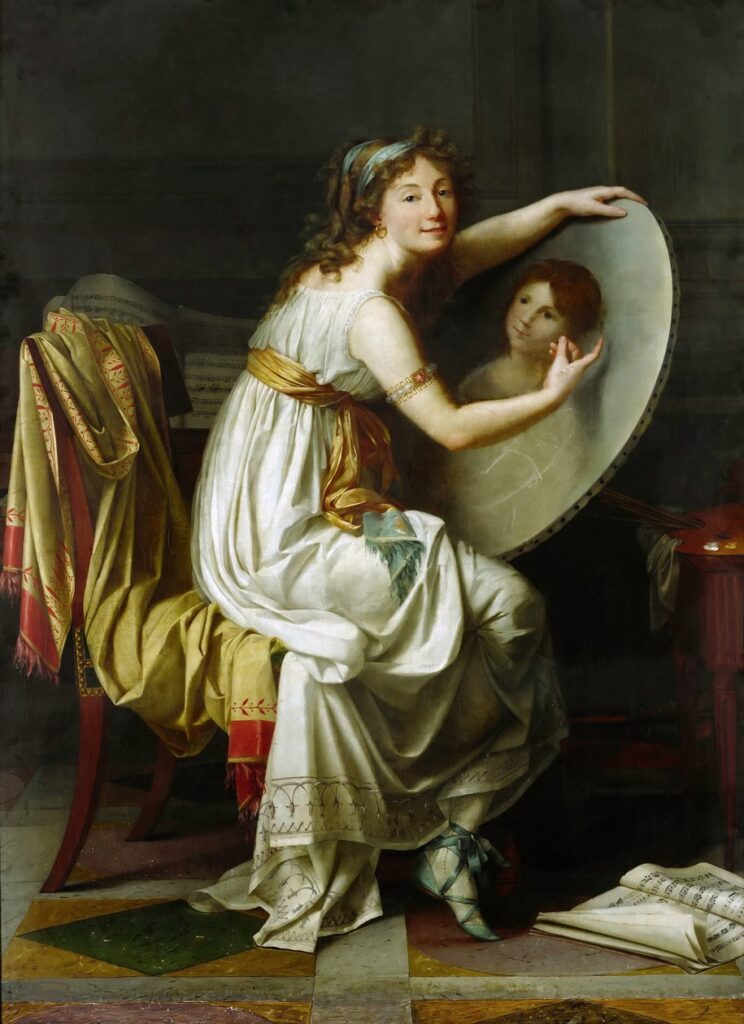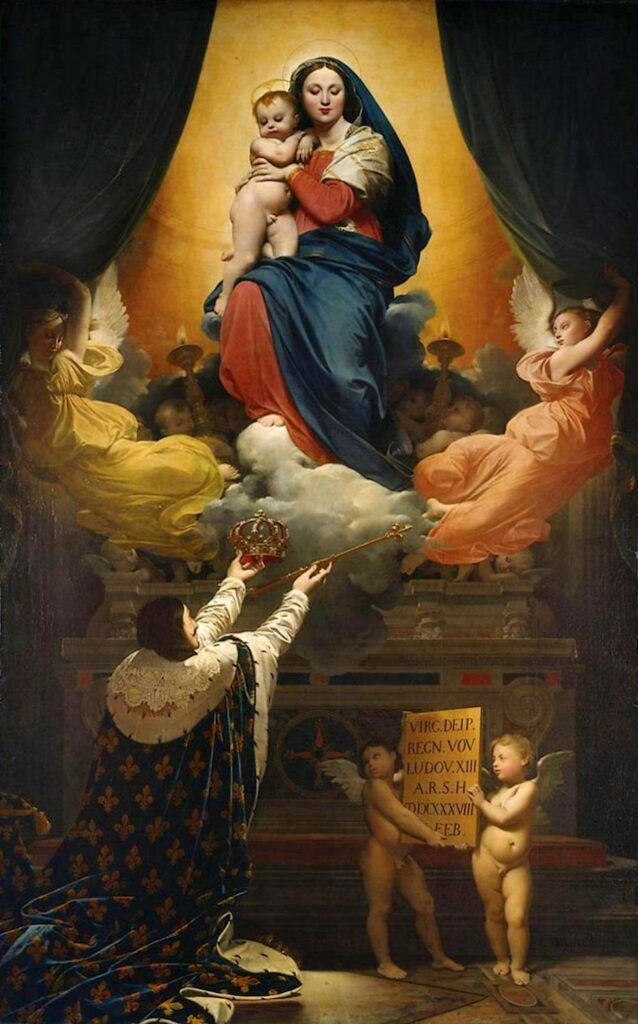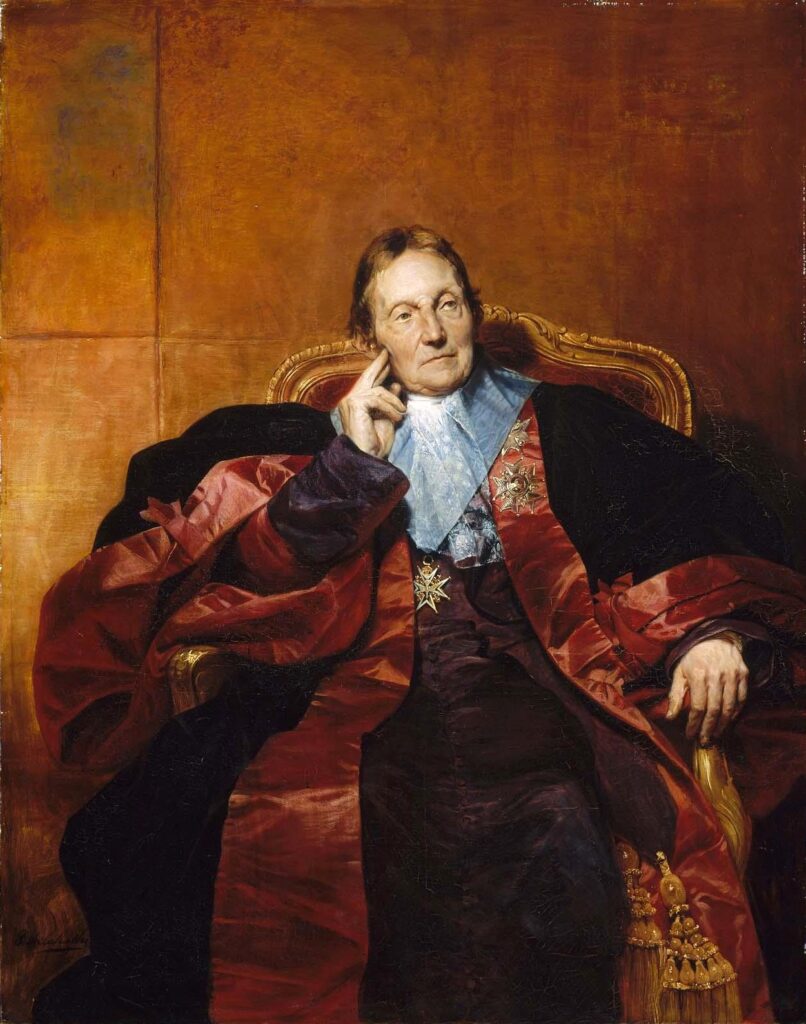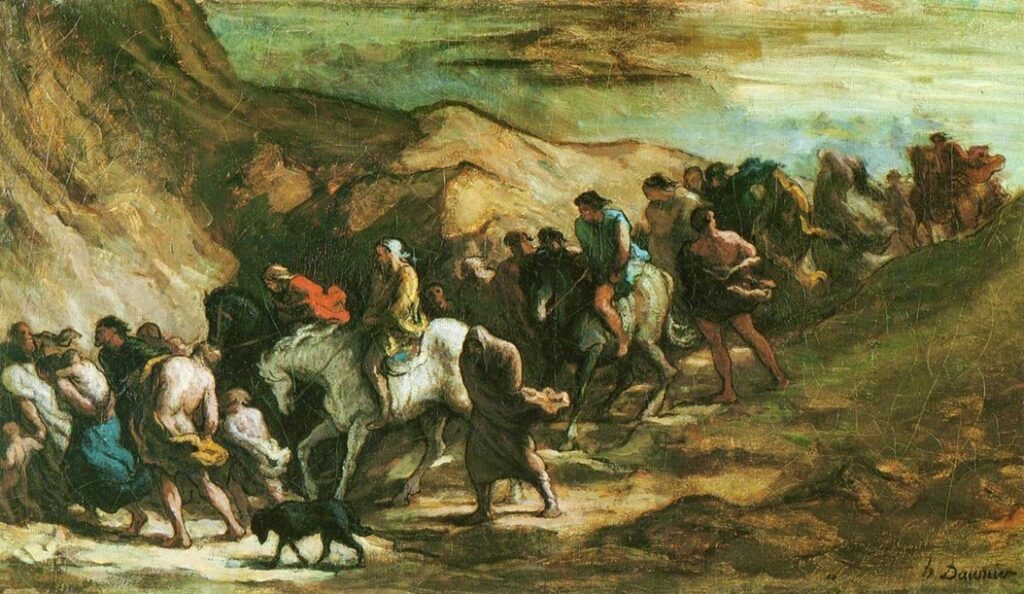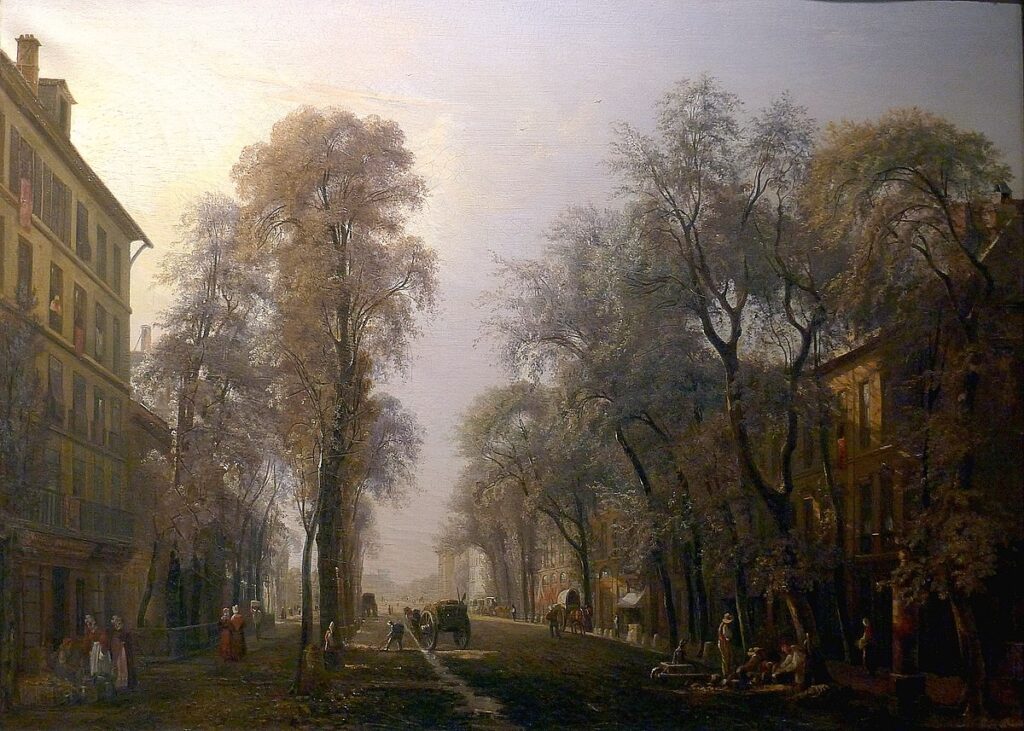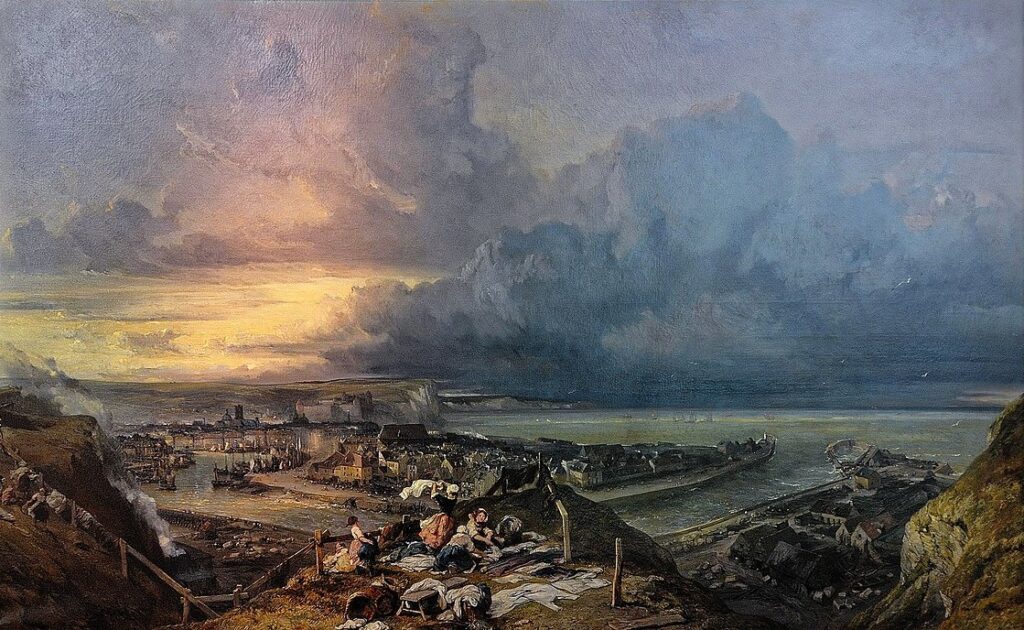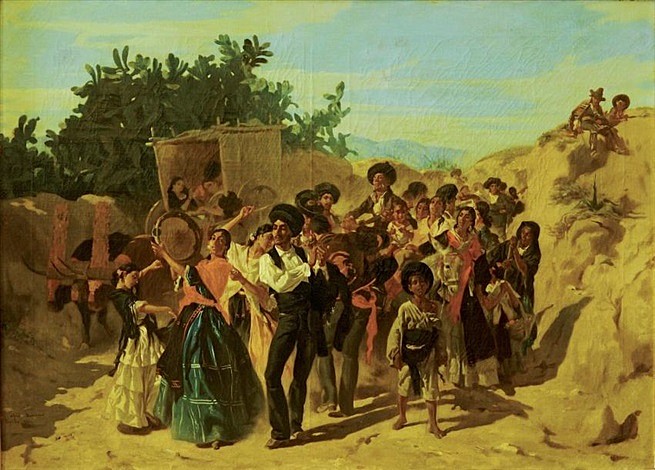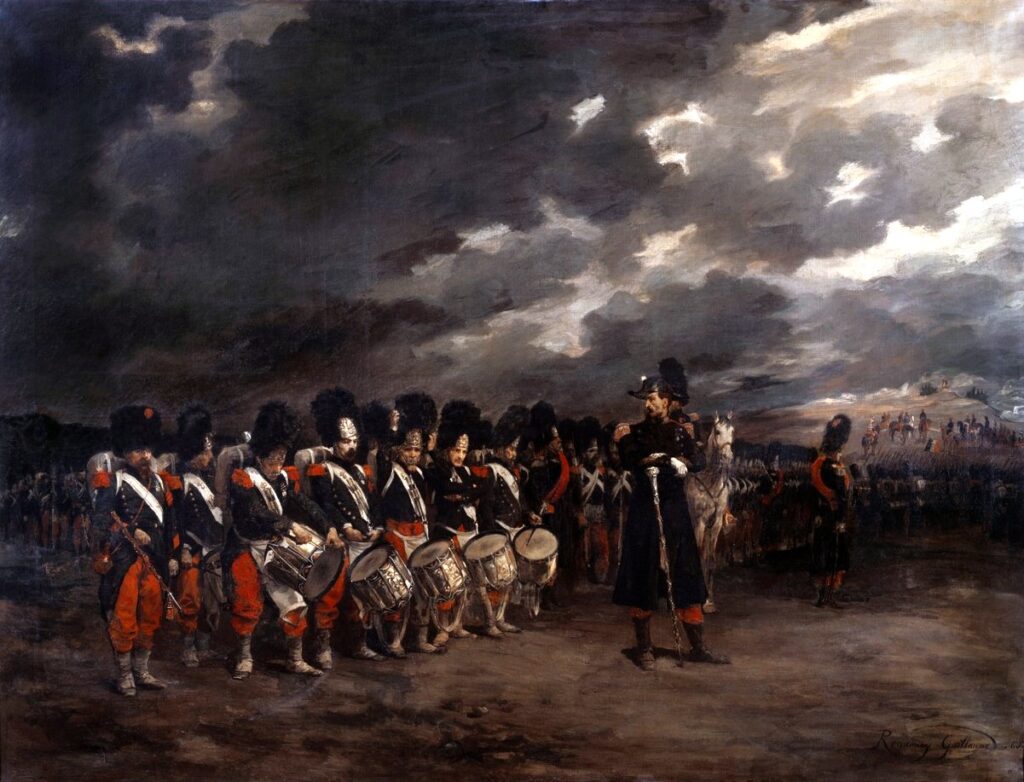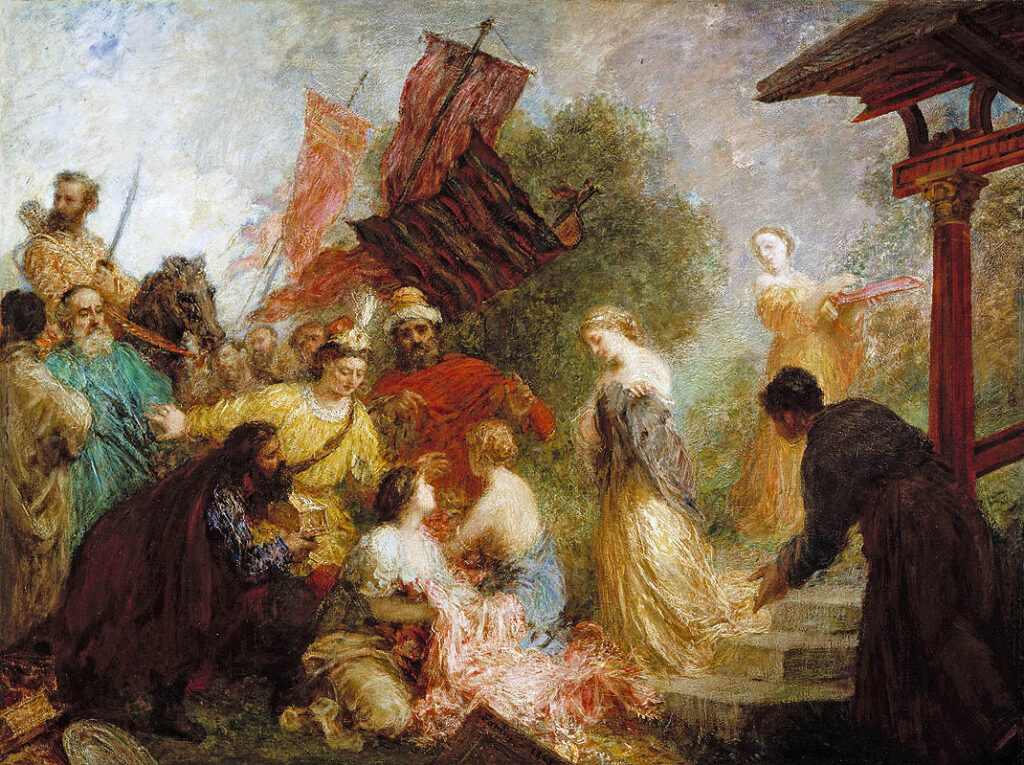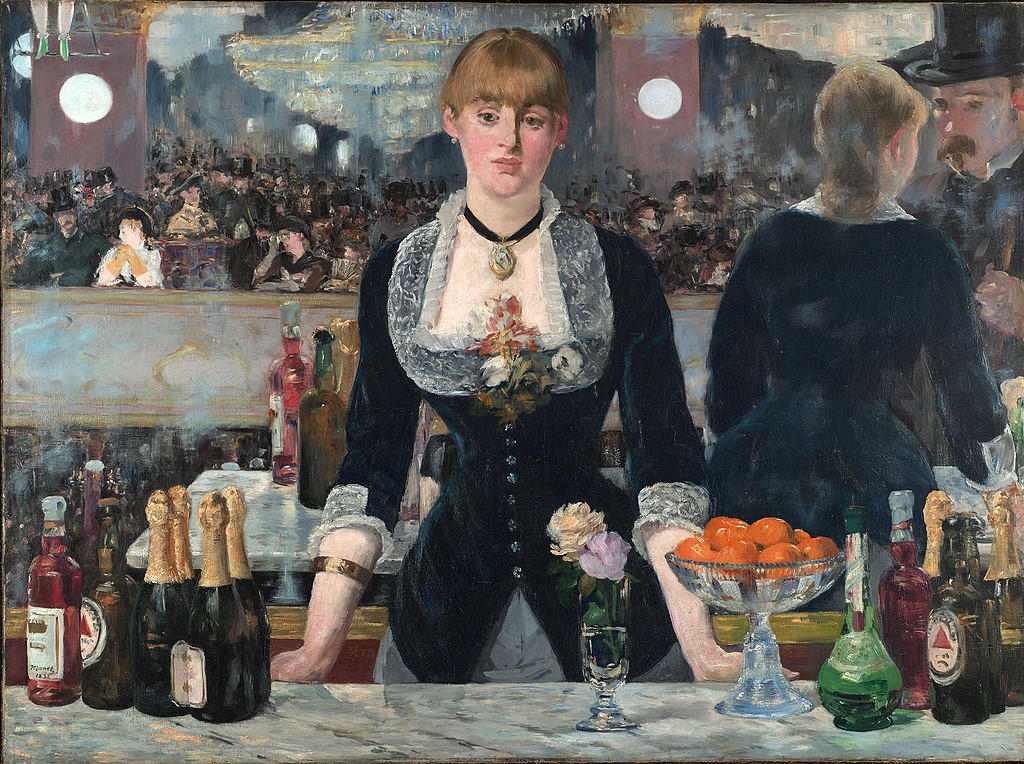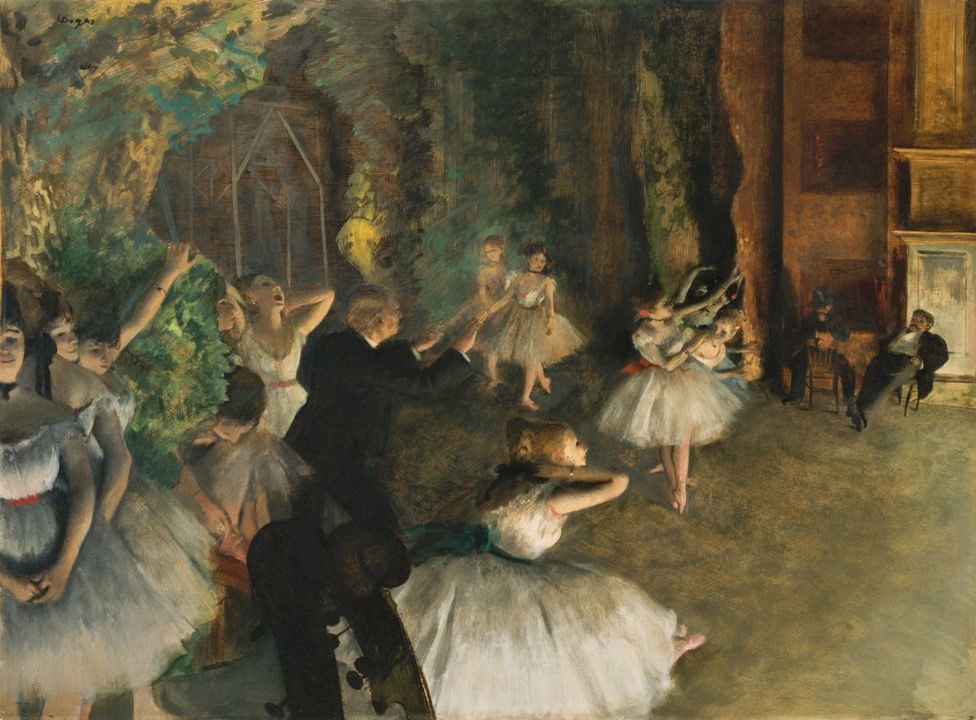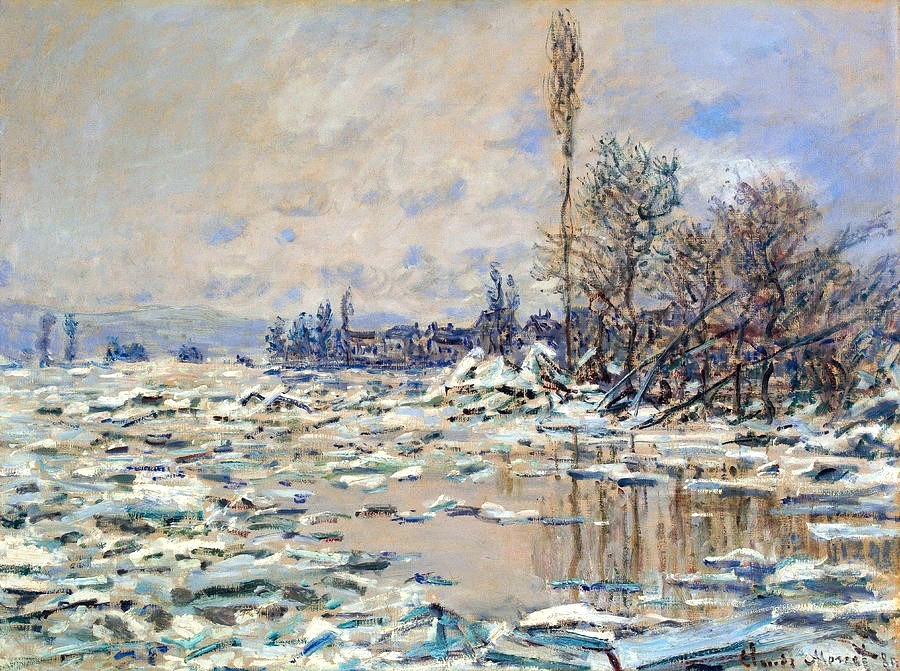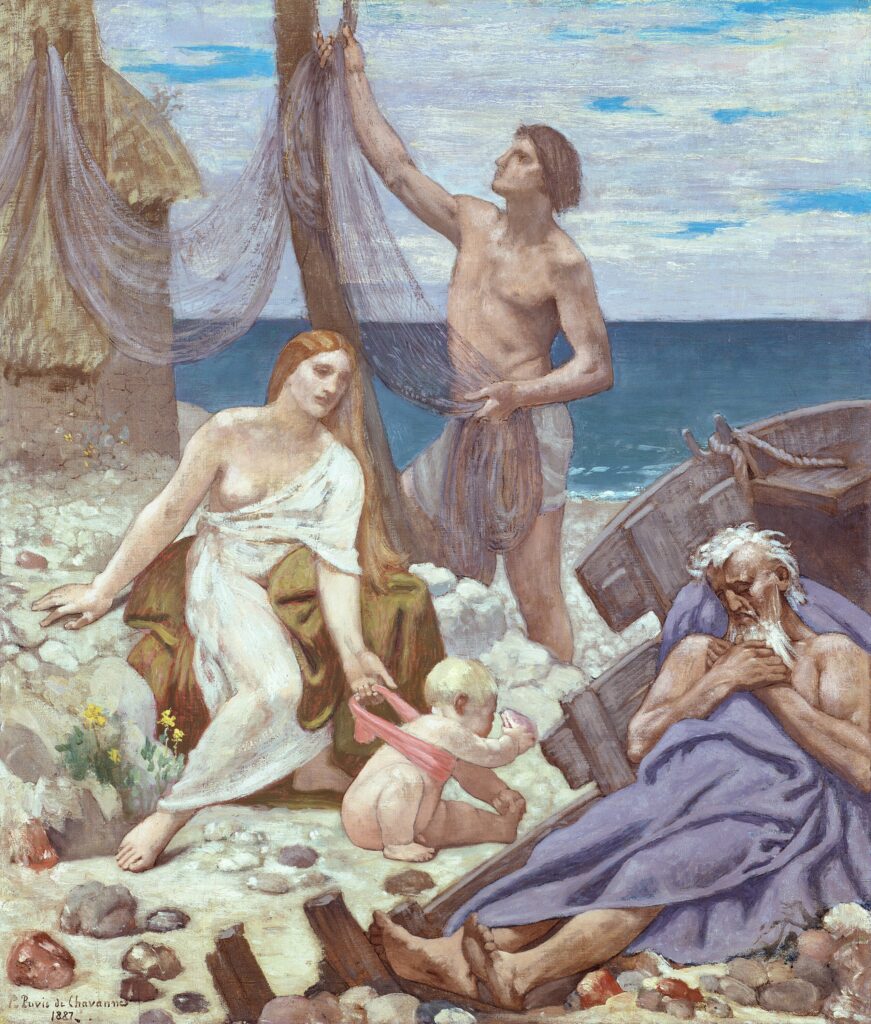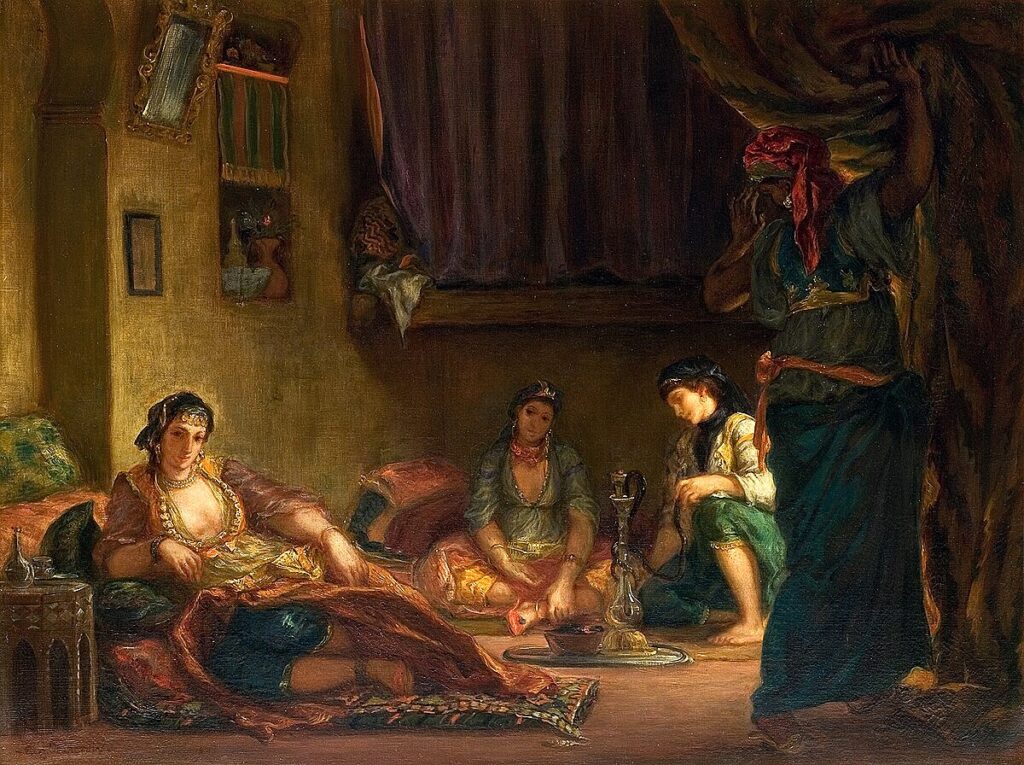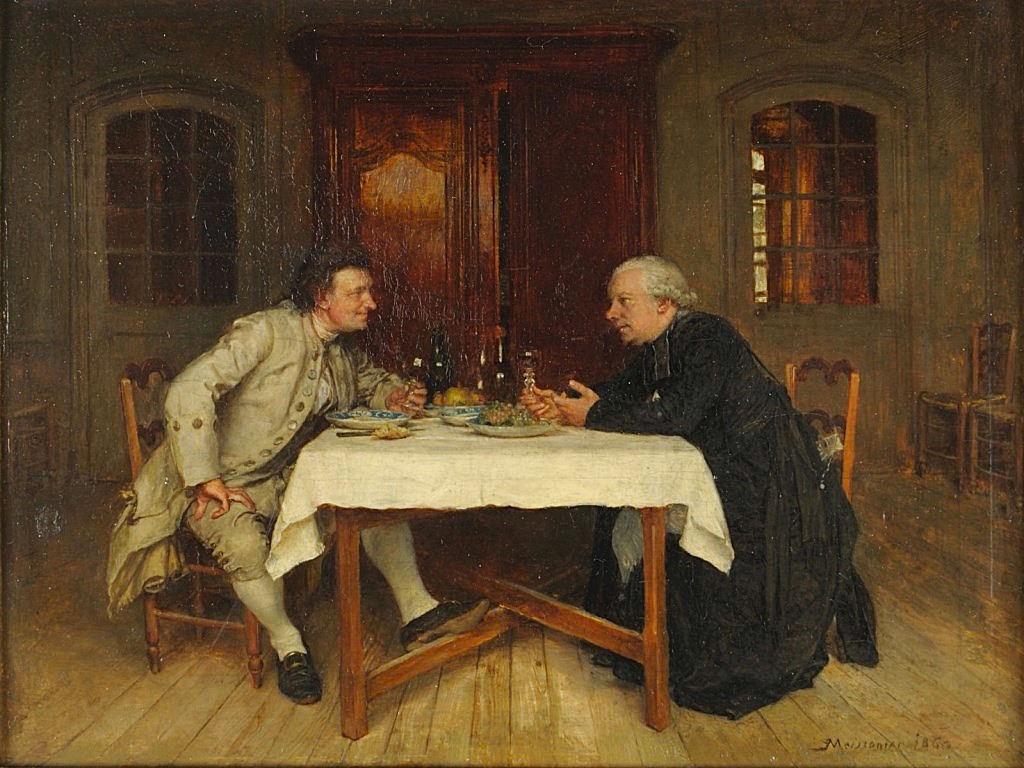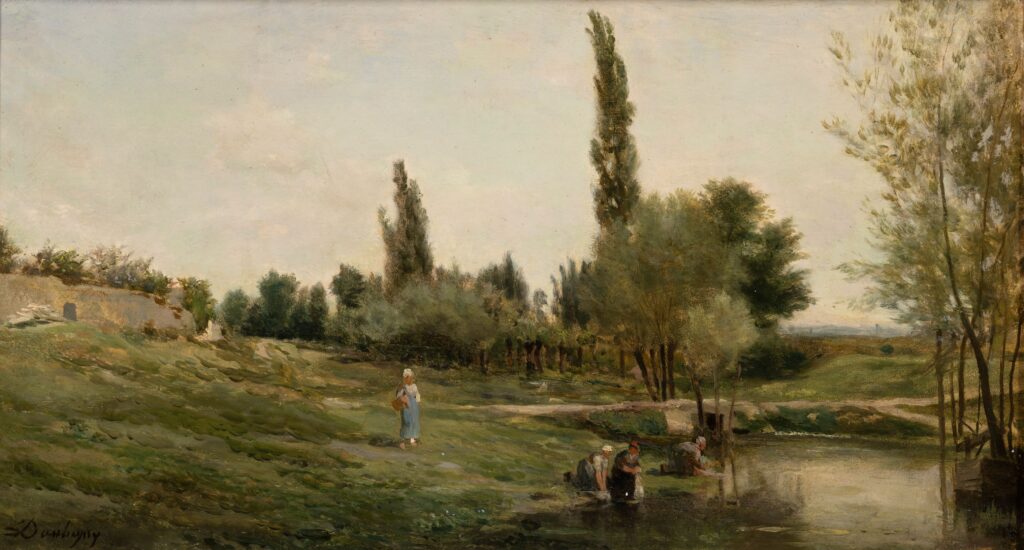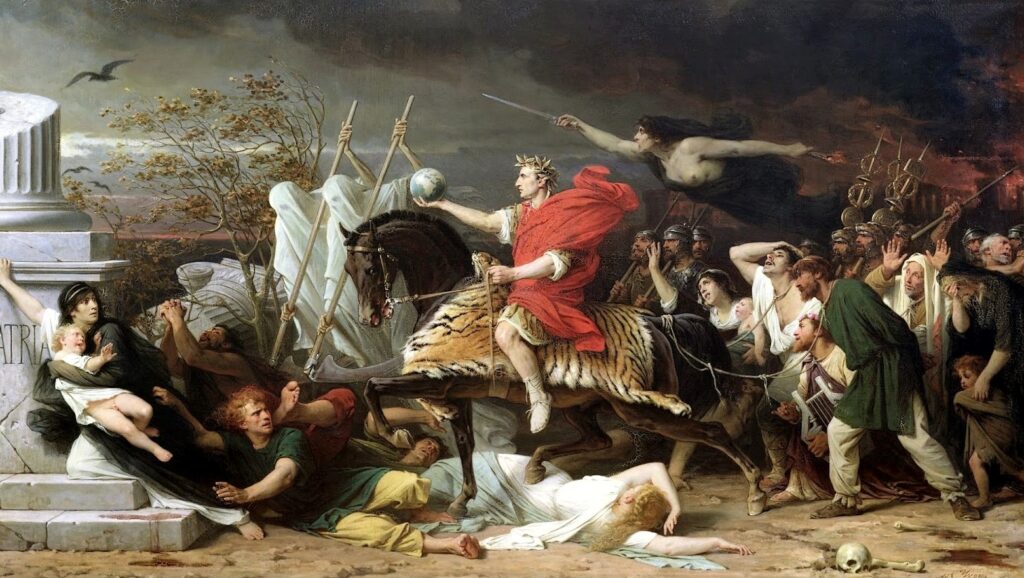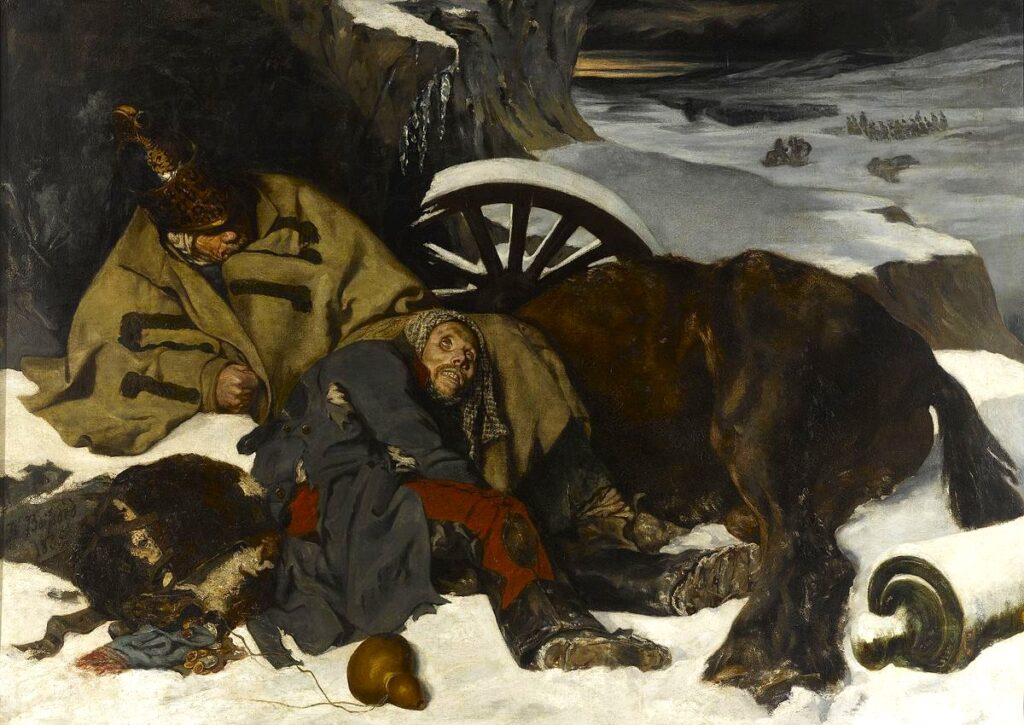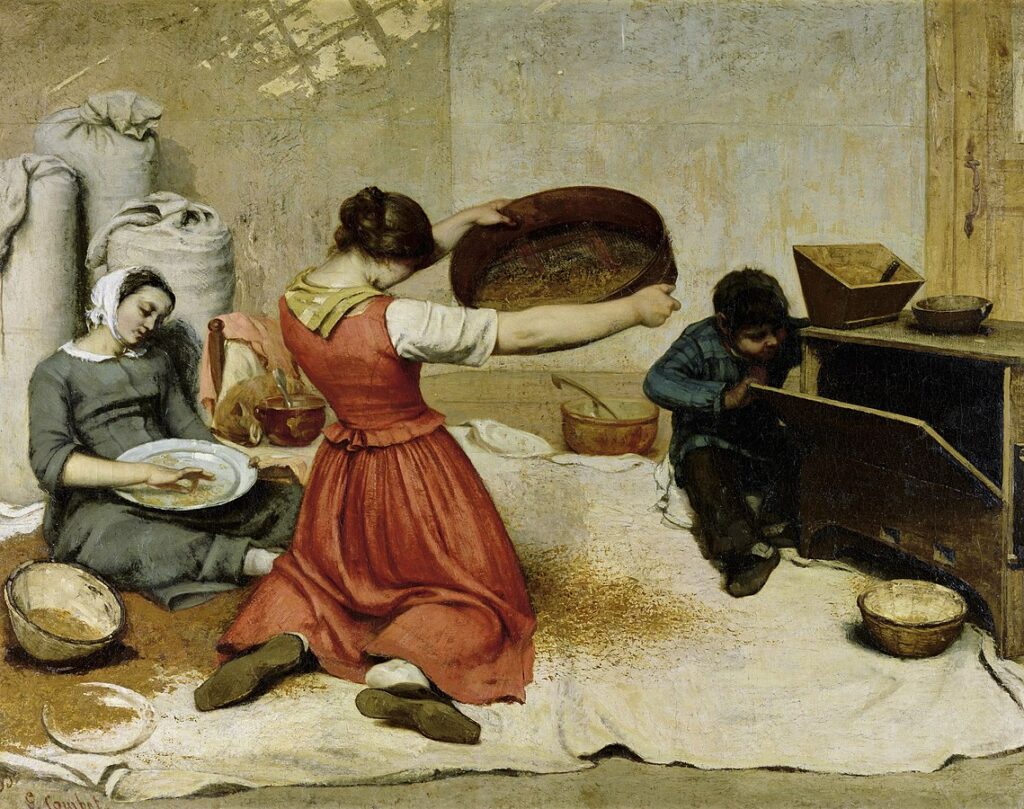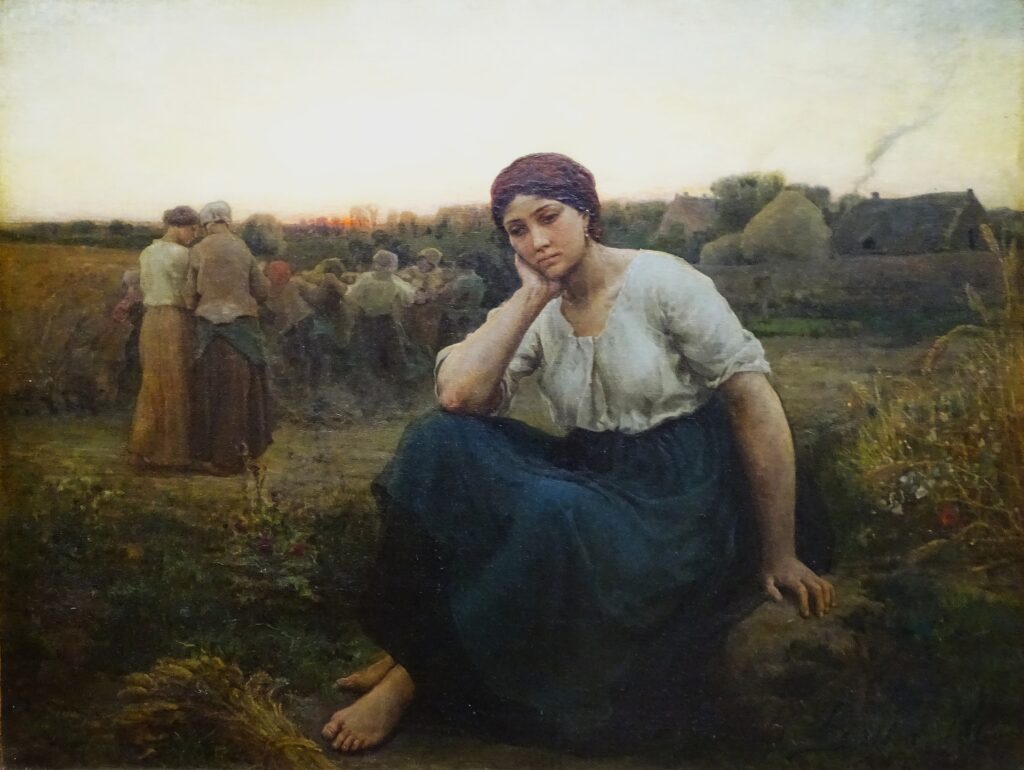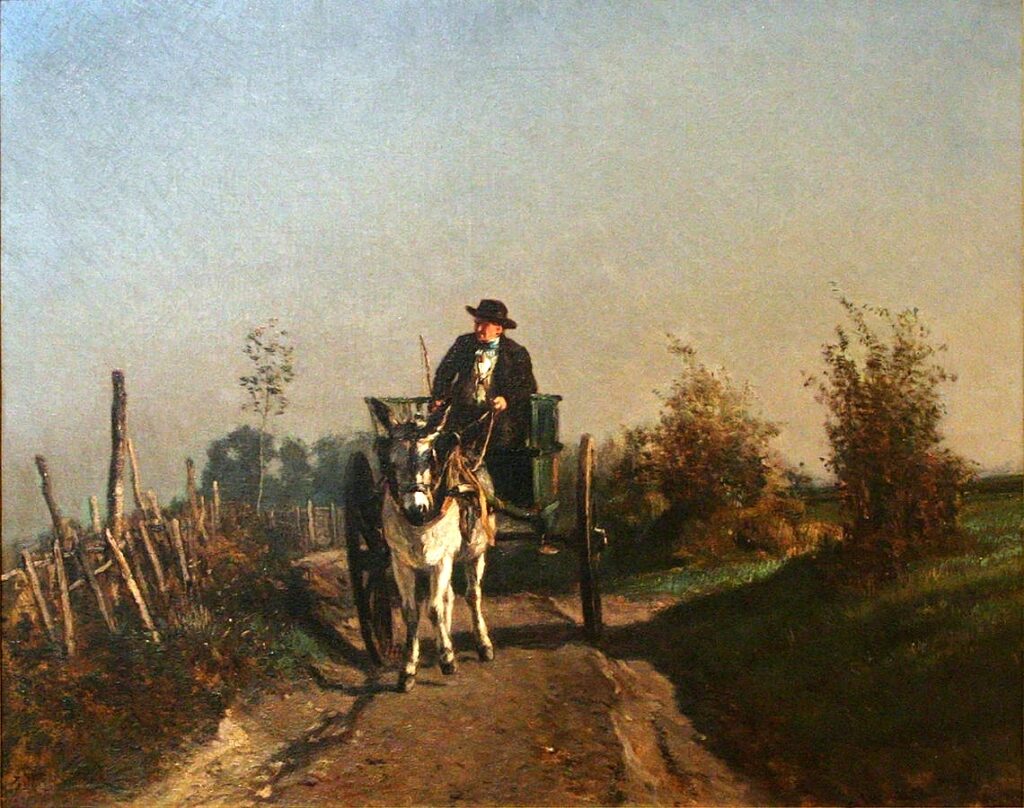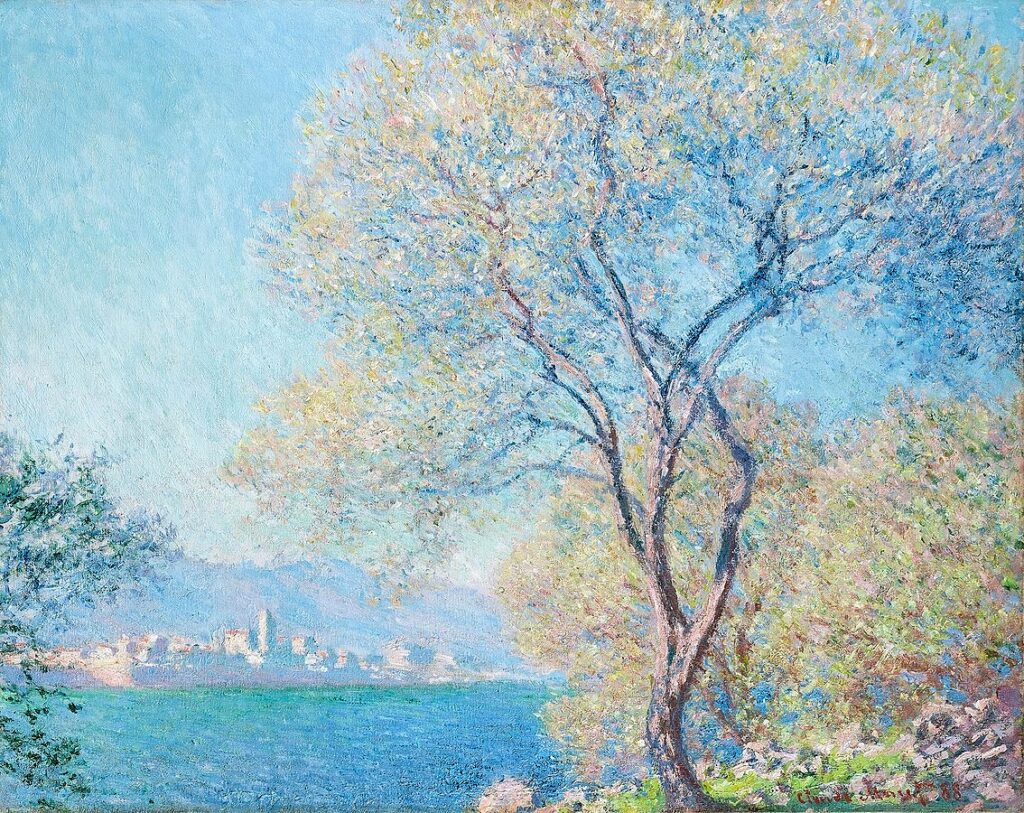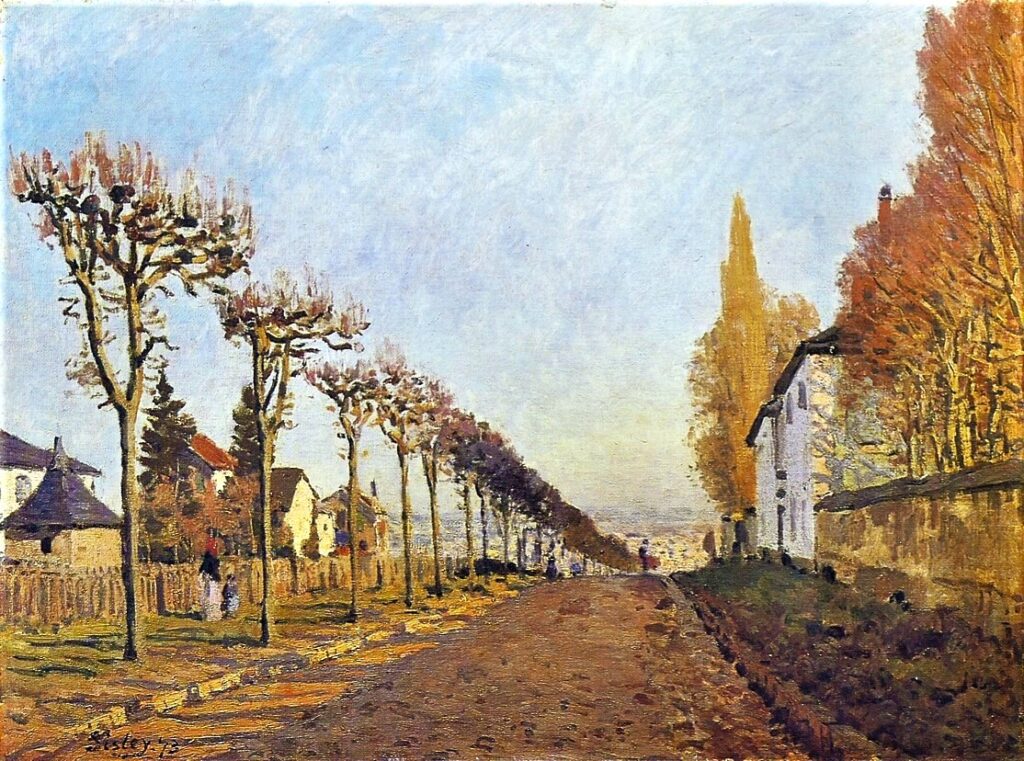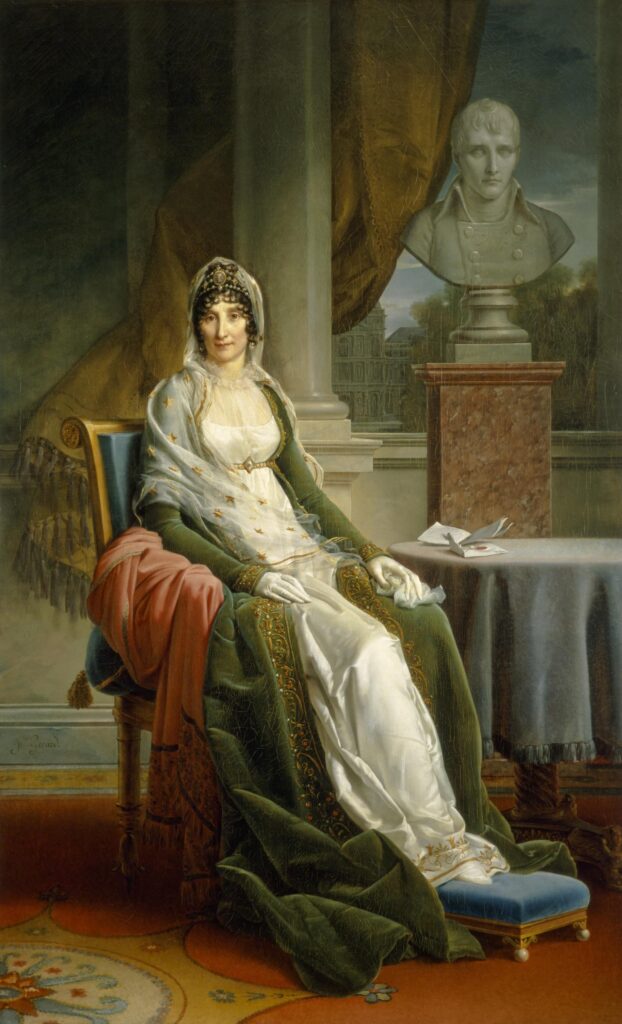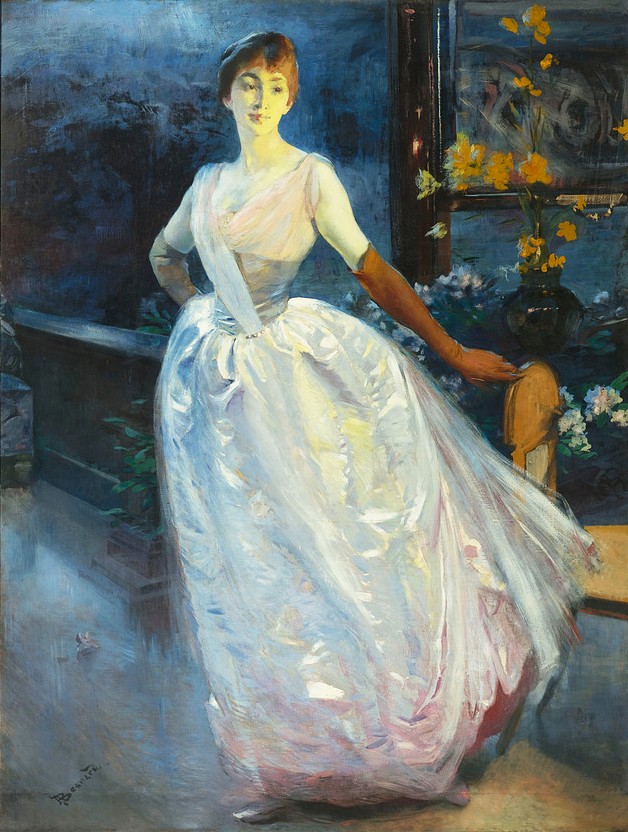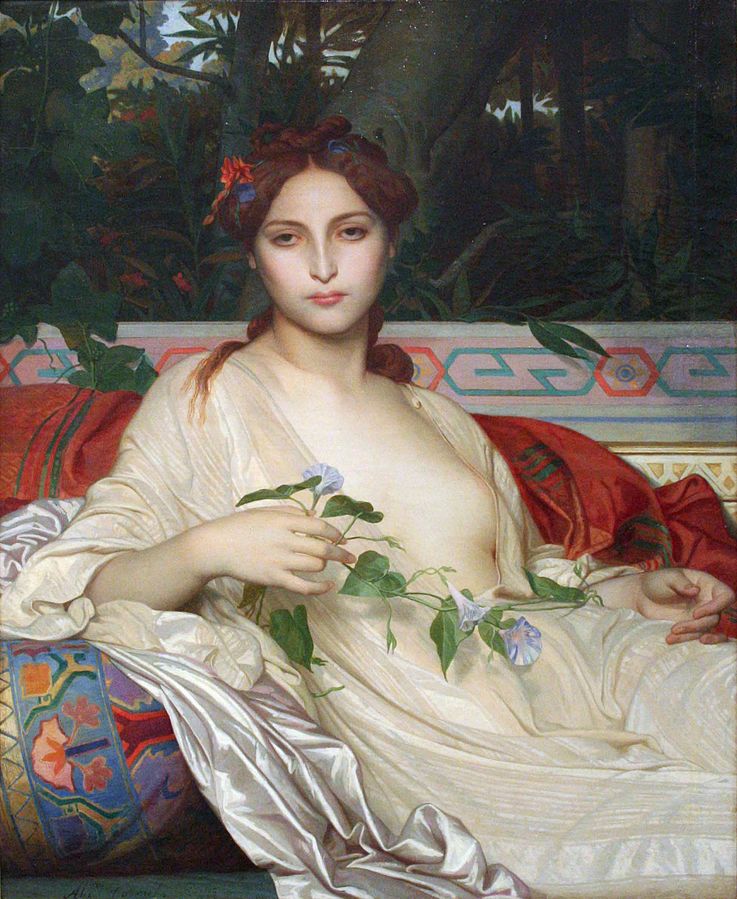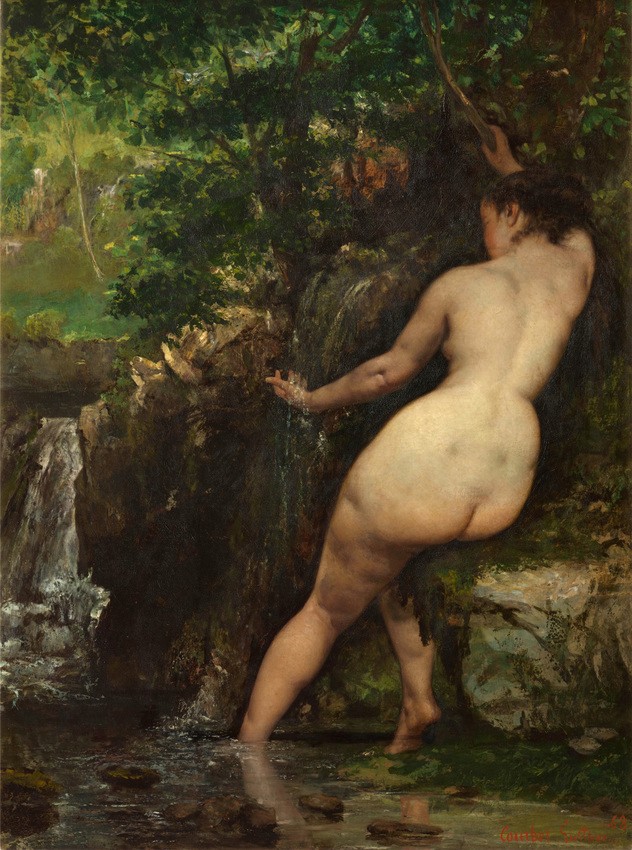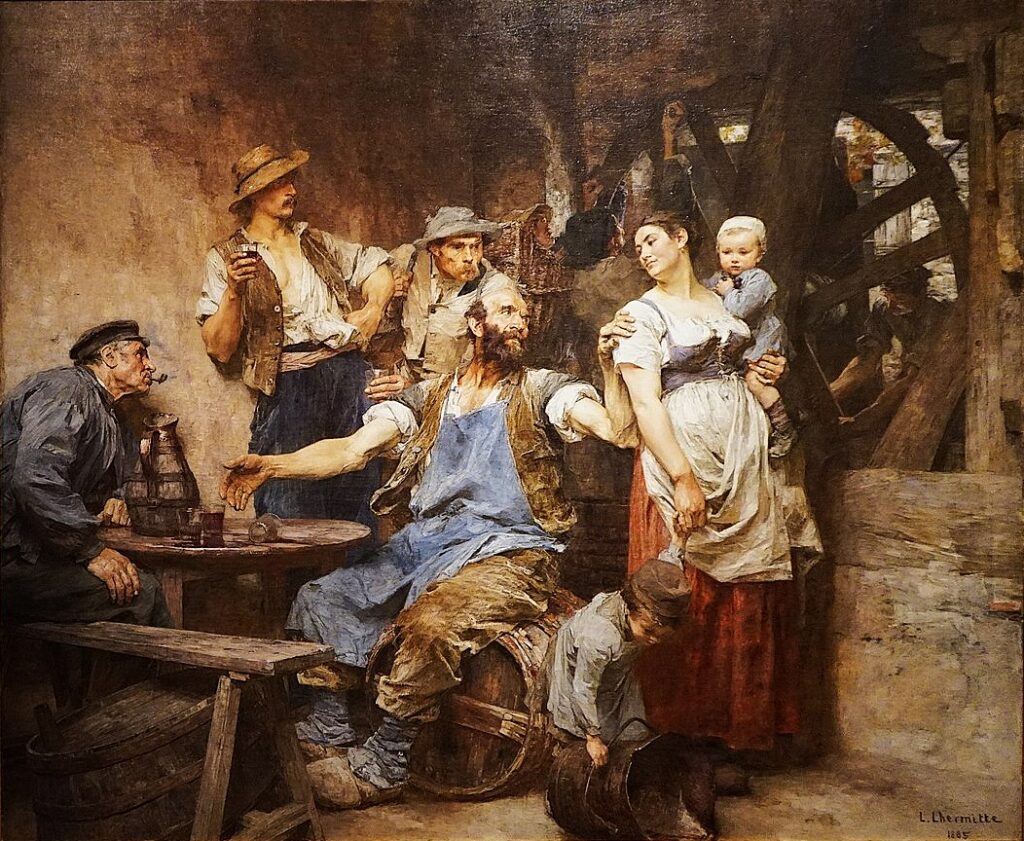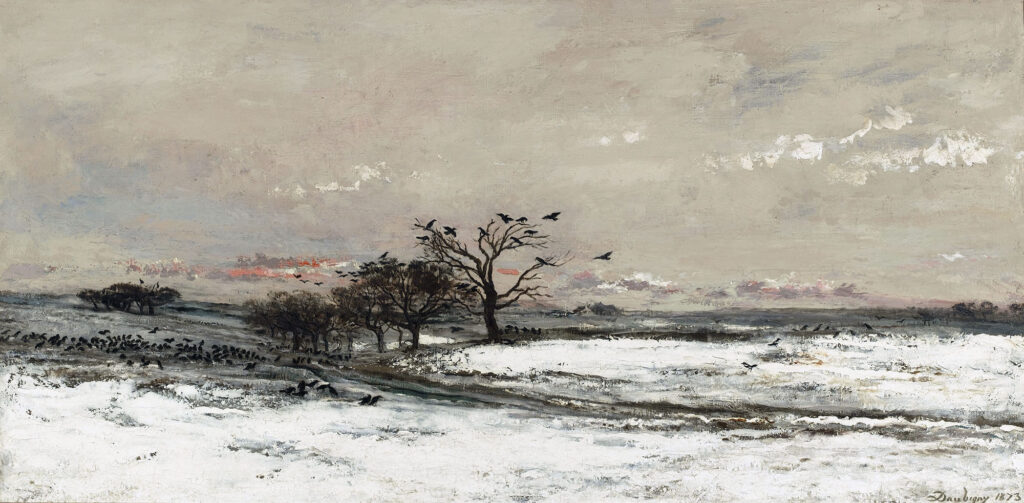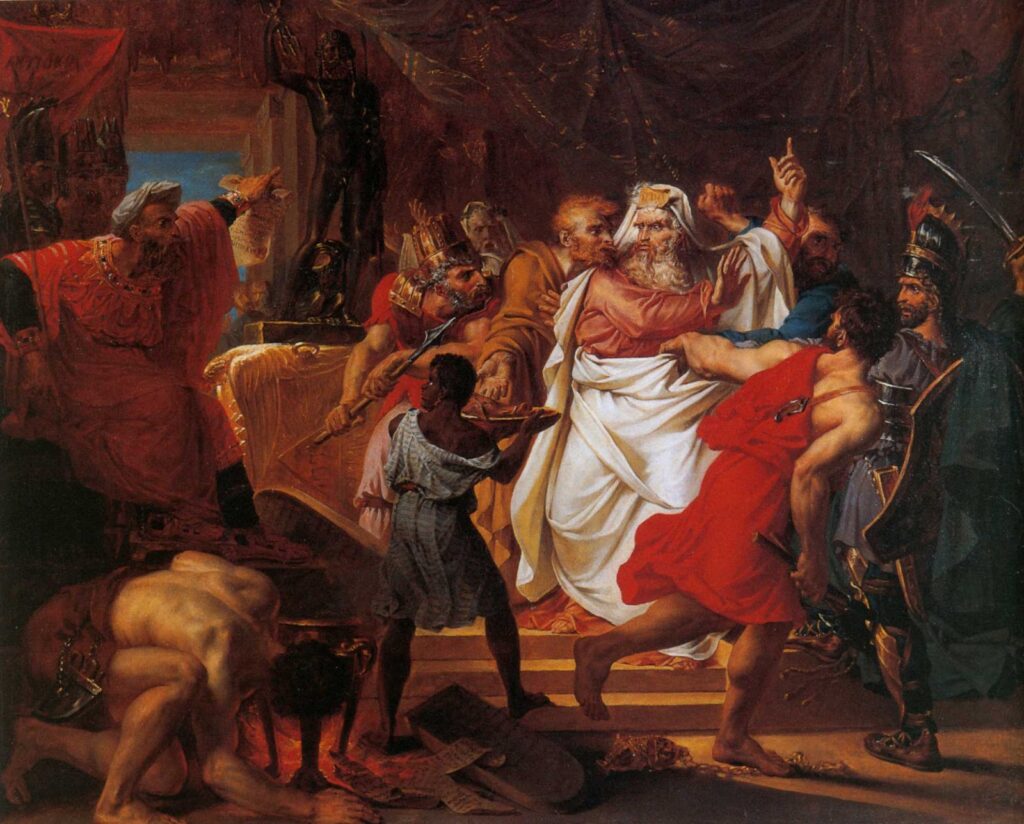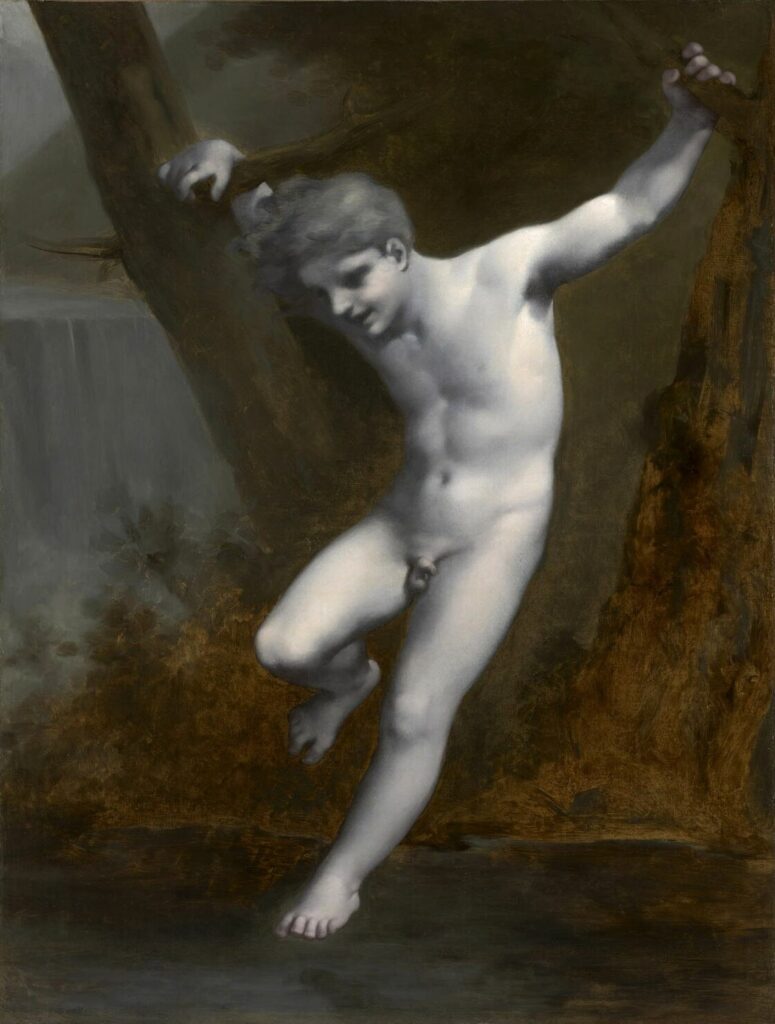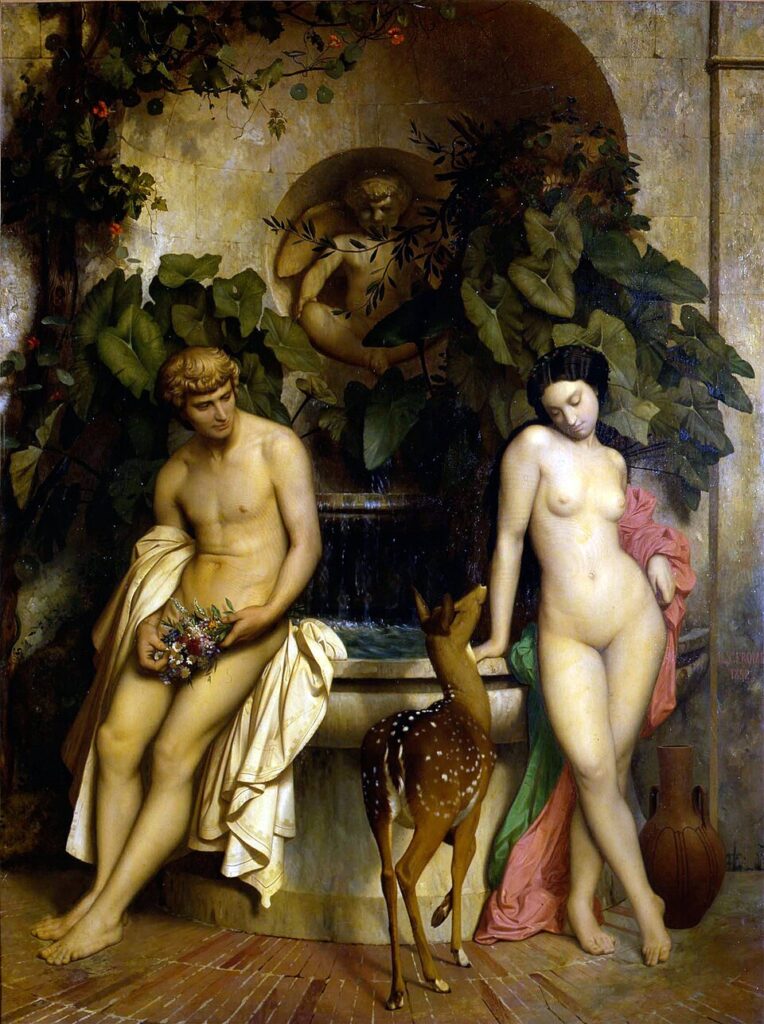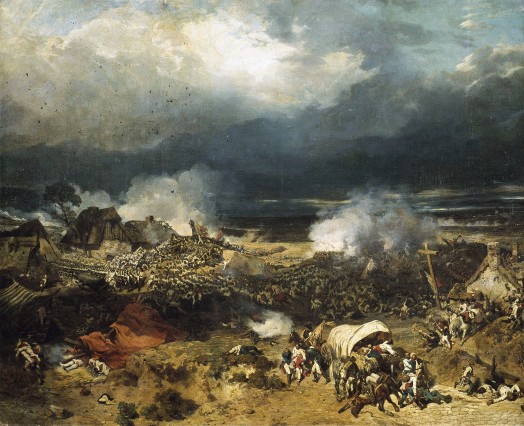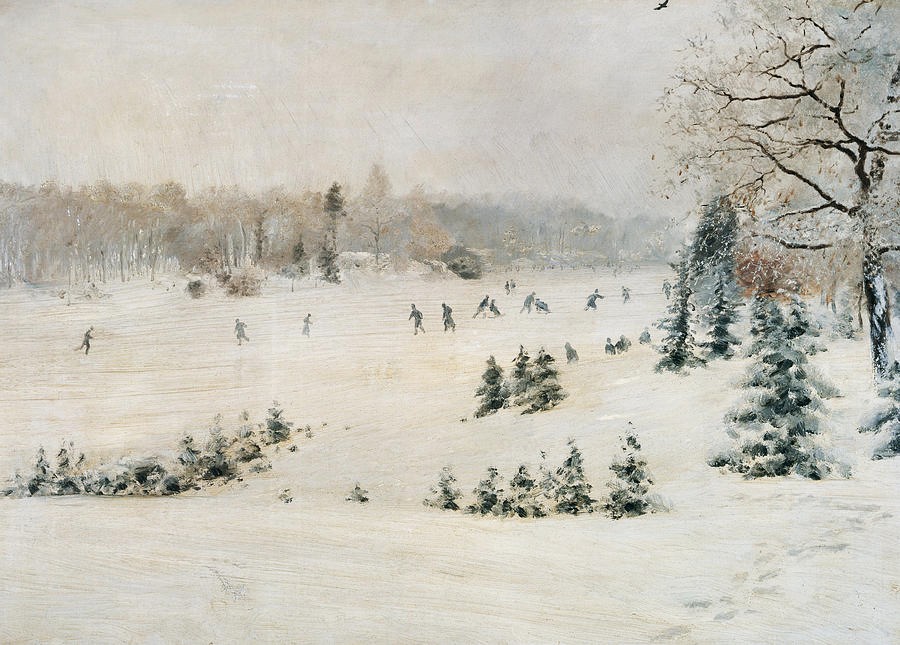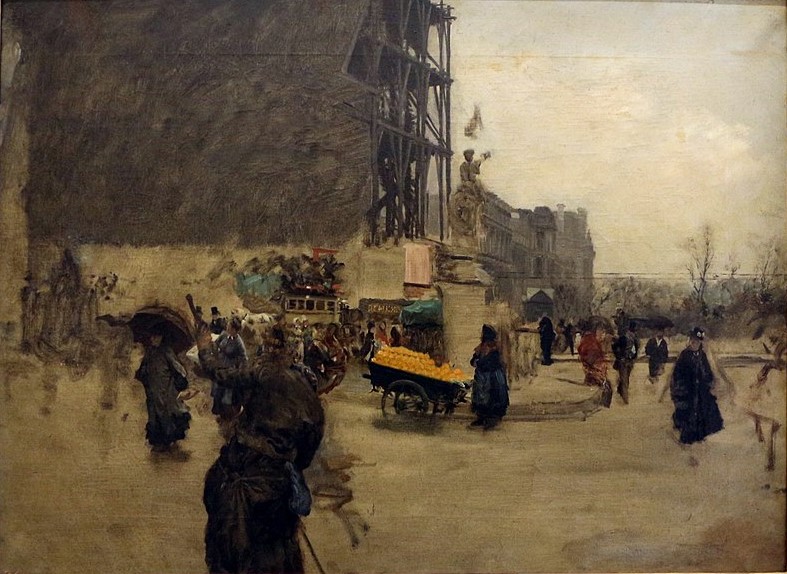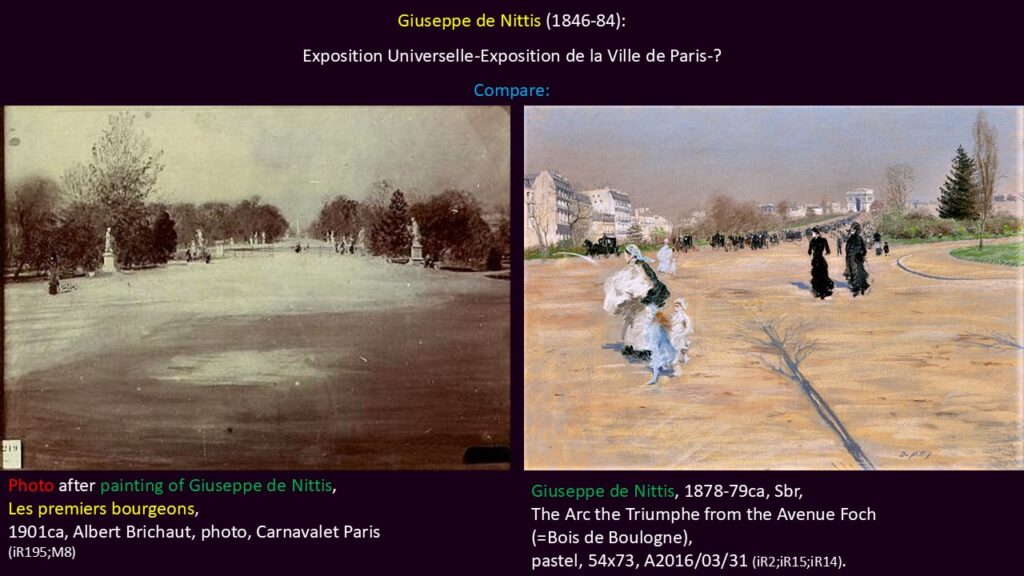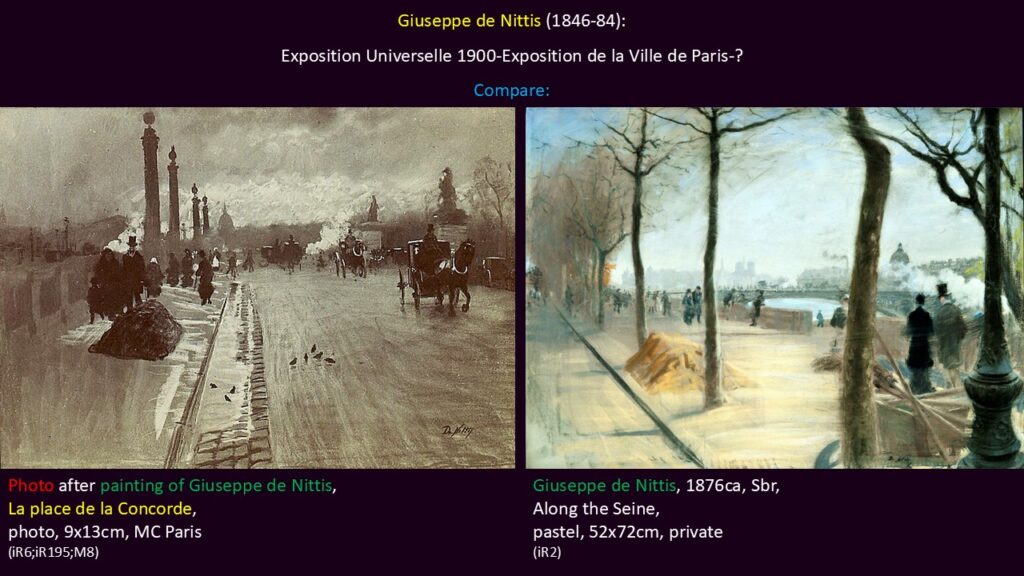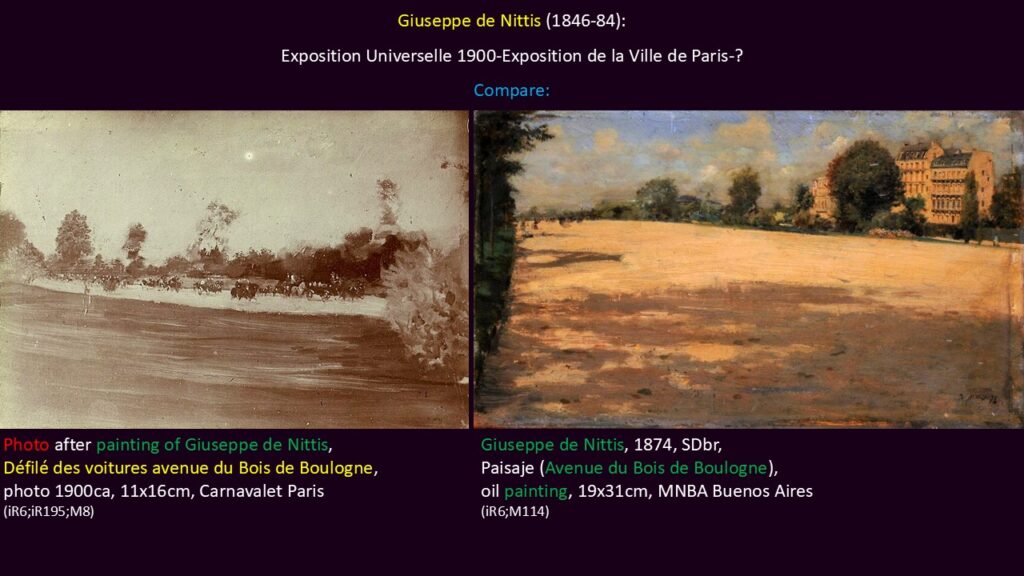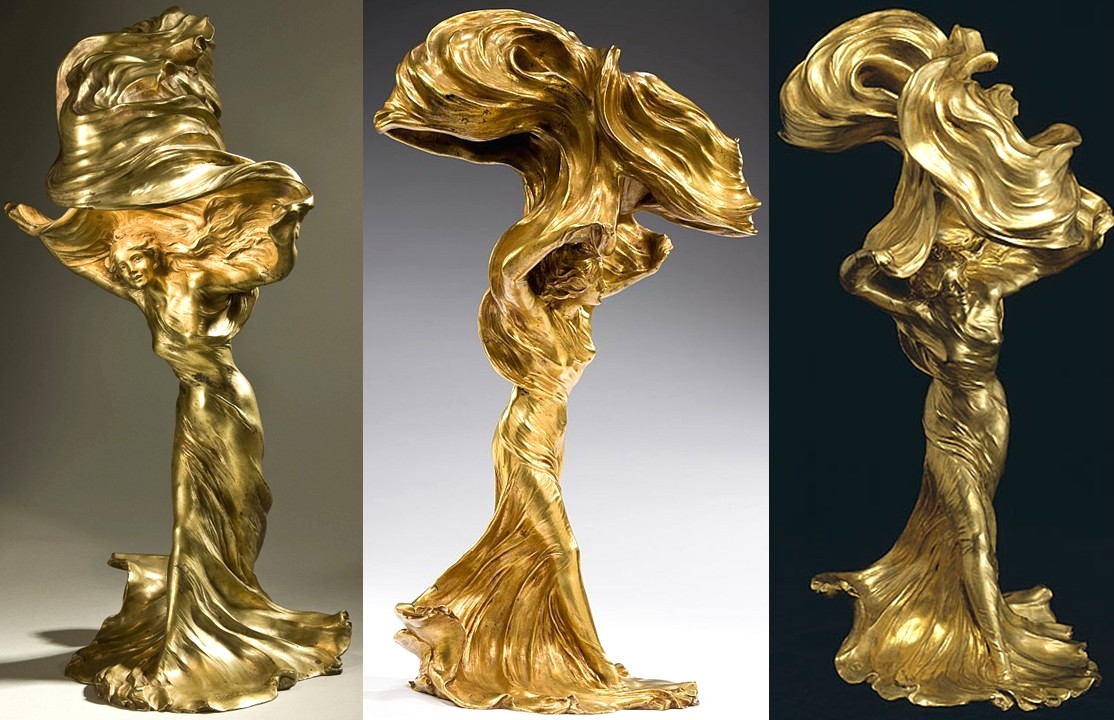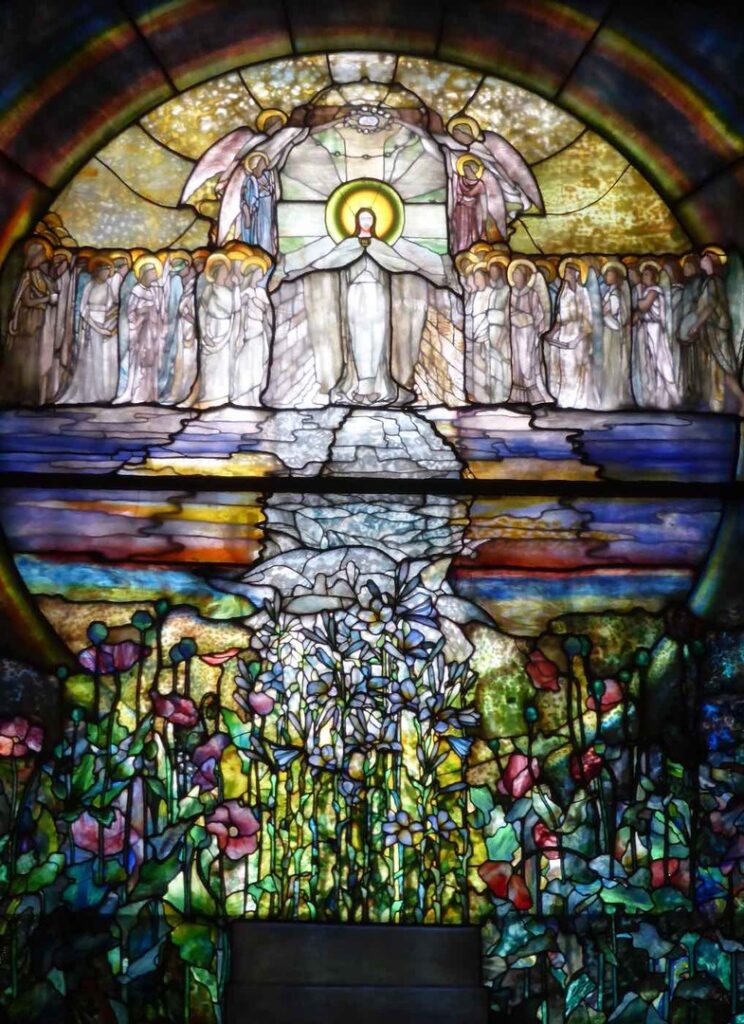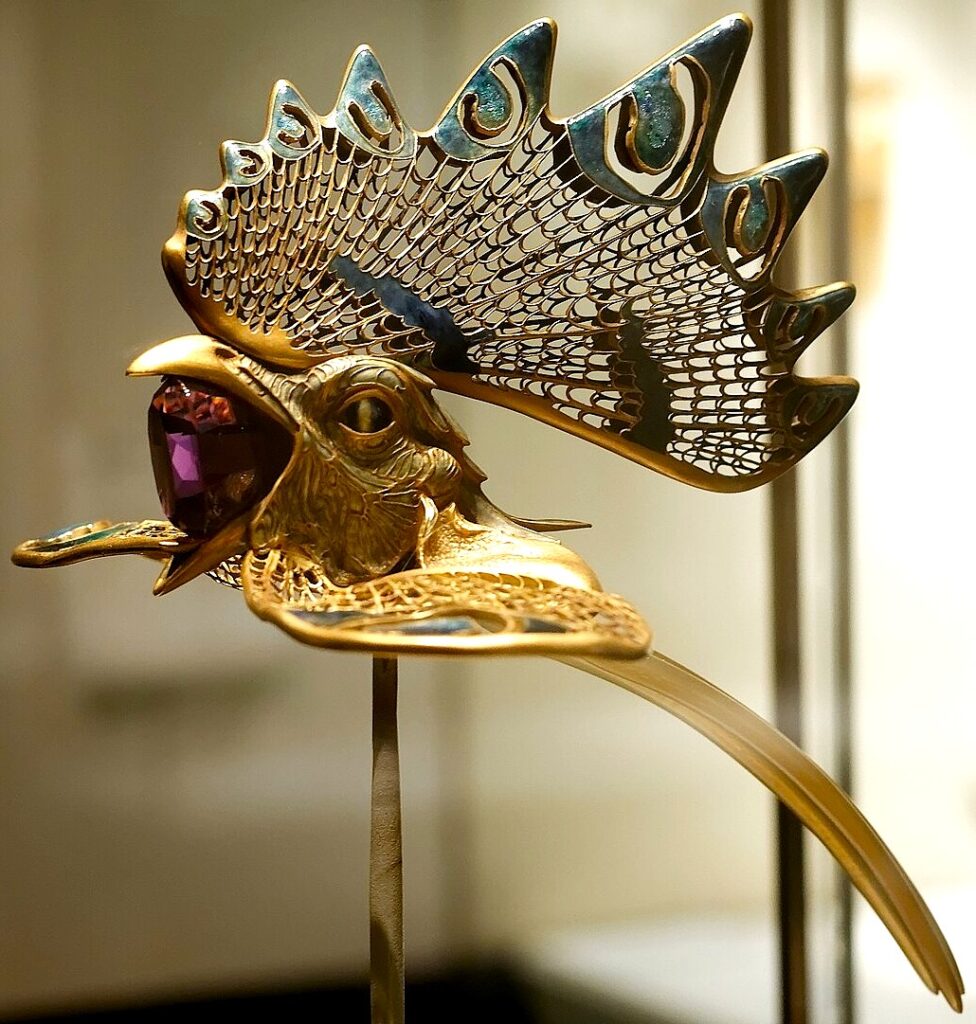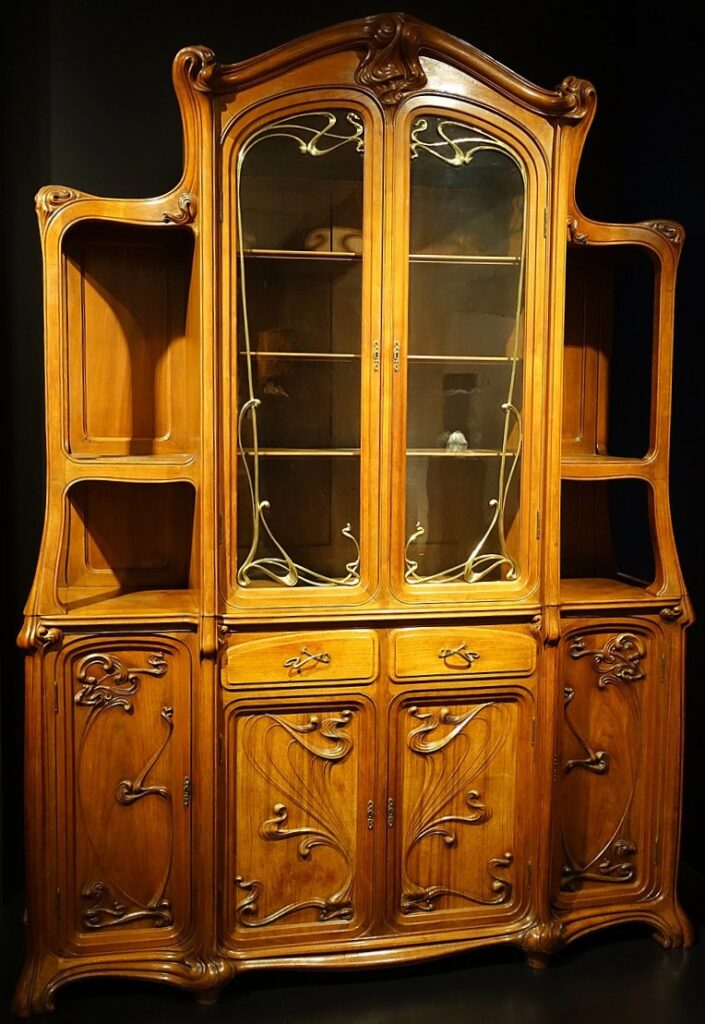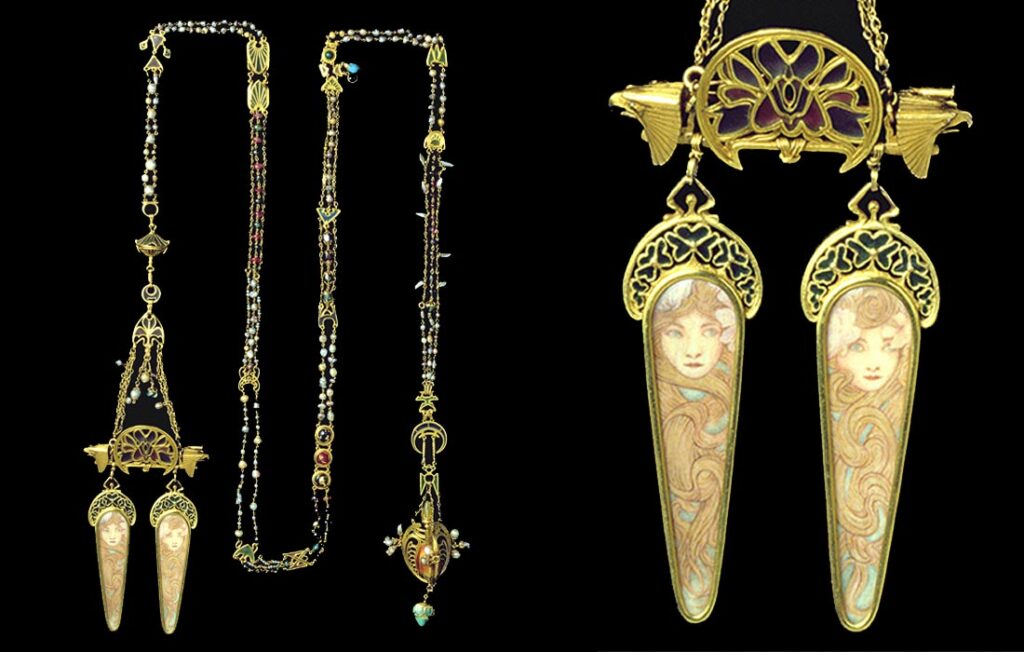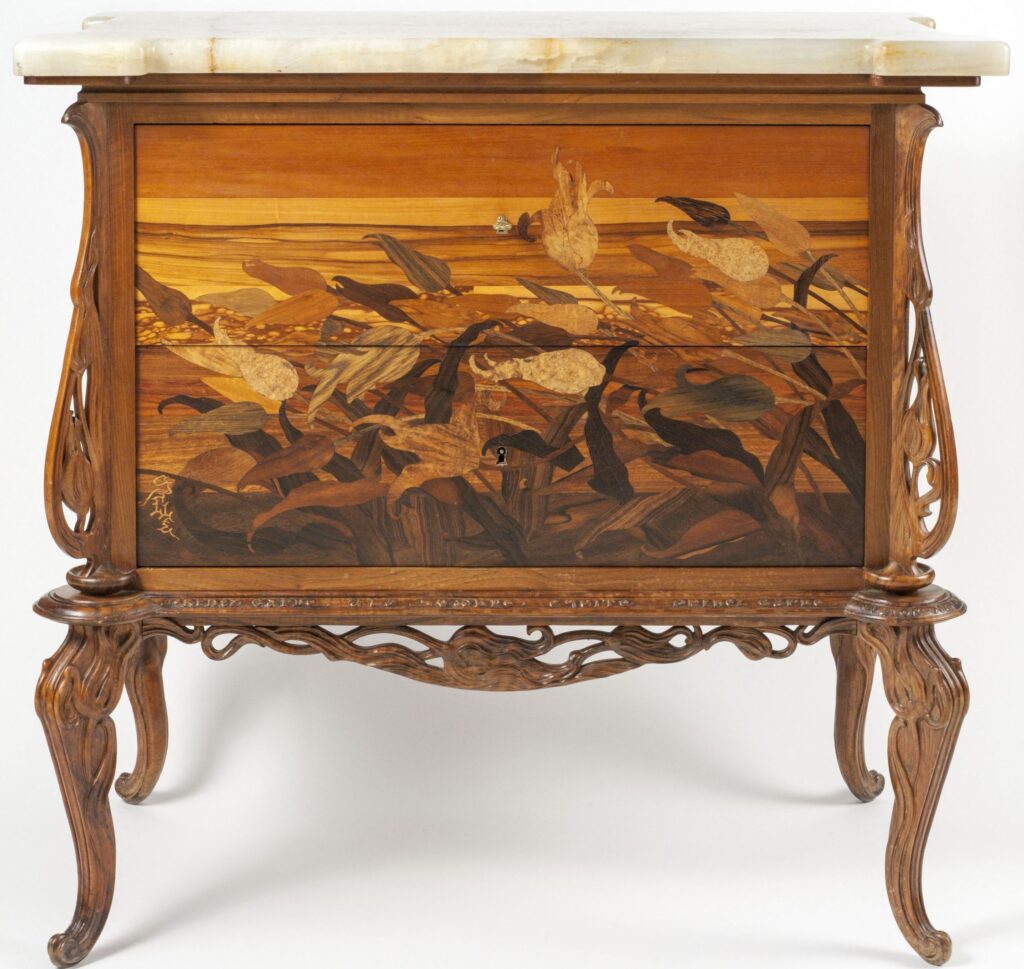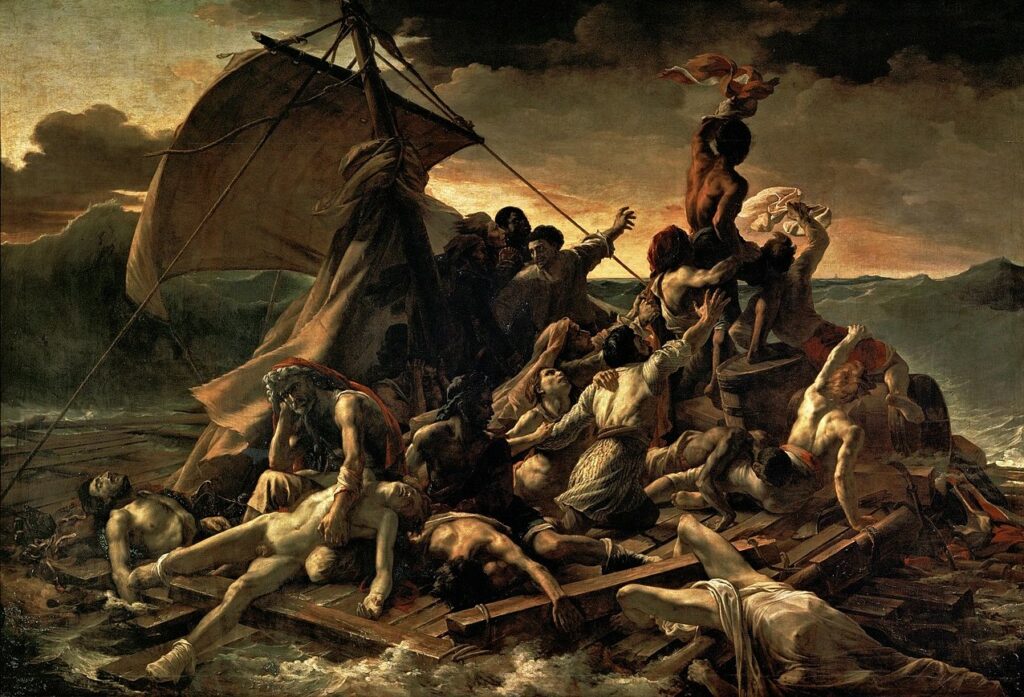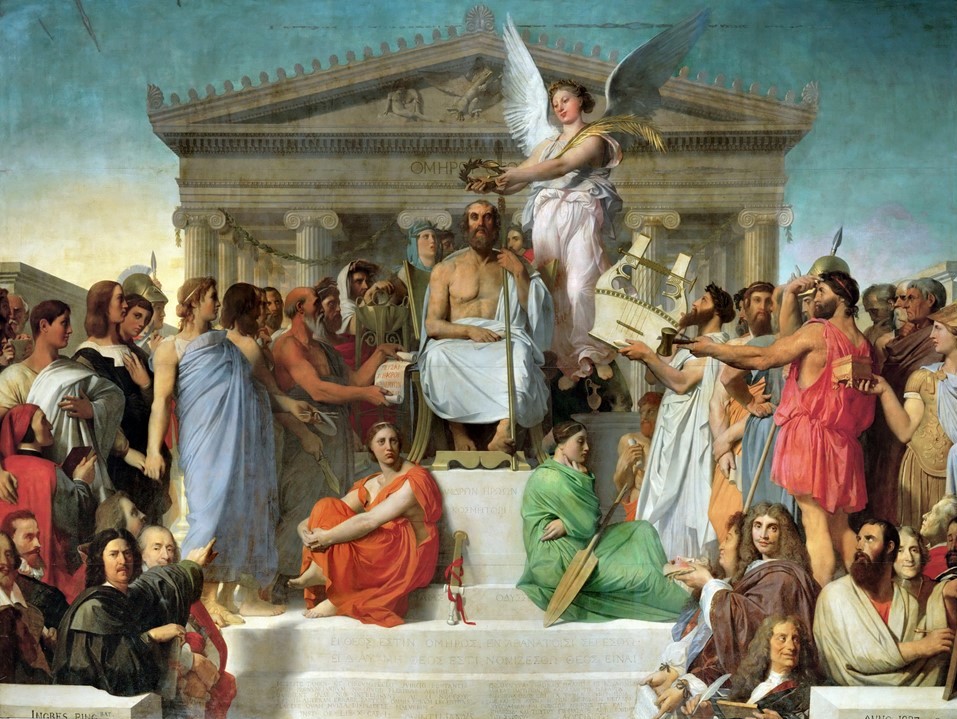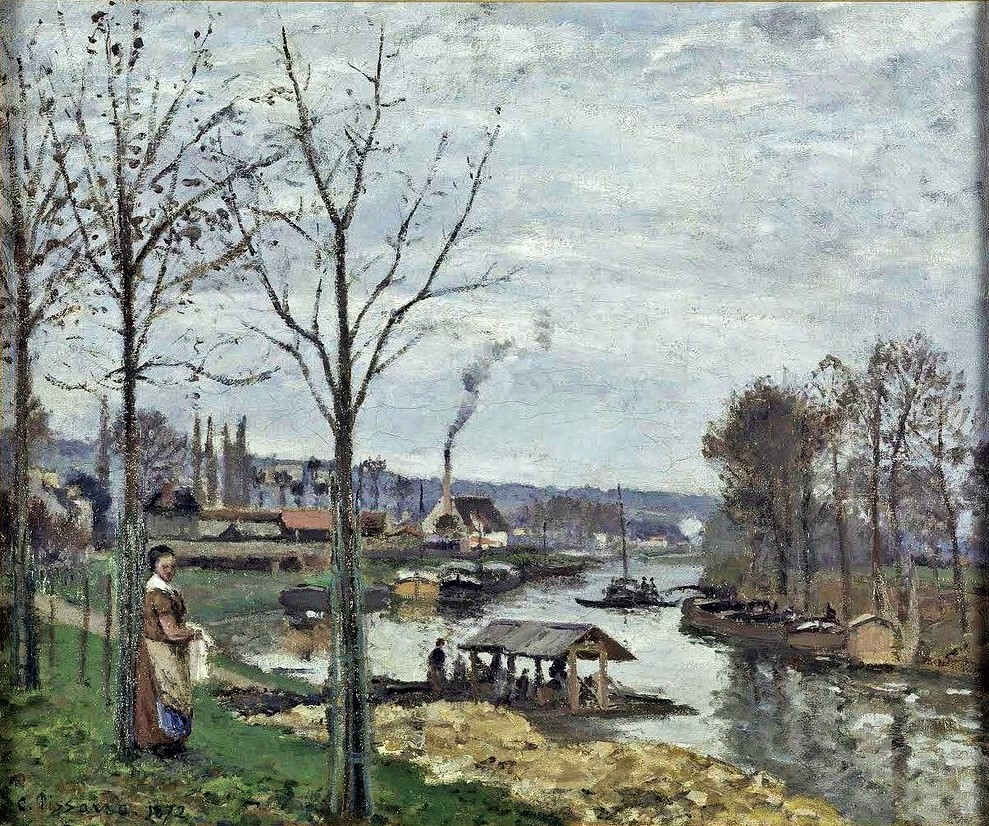Meta-Impressionism / Other exhibitions
Exposition Universelle
1900
Overview art exhibitions
Introduction:
On this page you will find some general information on the Exposition (Internationale) Universelle in 1900 in Paris. But, the focus is on the art exhibitions one could visit. Namely the official international Exposition Décennale des Beaux-arts (1889-1900) (=EU-1900-D). And also 2 national, French exhibitions: the Exposition Rétrospective de l’art Français with namely applied art-works made before 1800 in the Petit Palais (=EU-1900-R) and the Exposition Centennale de l’Art Français (1800-1889) in the Grand Palais (=EU-1900-C). At the Decennial and Centennial exposition one could see paintings made in various styles and depicting various themes. On this page you will find examples. At the bottom of this page you will find short info on other art exhibitions. On this page you will find general info and several pictures of these exhibitions. The focus is on exhibited paintings.
See seperate pages on the international Universal exhibitions, the Expositions Universelle in Paris held in 1855, 1867, 1878, 1889 and now in 1900. See seperate pages with namely pictures of the Decennial expo, the Centennial expo (including one with a chronological overview) and one with background info (on the 1900 catalogues).
The Exposition Universelle in general:
The inauguration of the Exposition Universelle was 1900/04/14 and the opening of the fine arts the 1st of May (R22I,p347). At that time several pavilions and exposition rooms were not ready yet. The Exposition ended shortly after the 12th of November (R481,p3).
The main entrance of the site, the Triumph gate, was just south-west of the Place de la Concorde (iR9). The site stretched on the right (north) bank of the Seine towards the newly build Pont Alexandre III, with in its continuance the Petit Palais* (to the east) and the Grand Palais* (to the west). Further westwards it stretched along the Seine, along the ‘Rue de Paris’ till the Palais de Trocadéro** with many pavilions. At the opposite bank of the Seine one could find the Eiffel tower*** and the Champs de Mars with many pavilions. Eastwards along the Seine, along the ‘Rue des Nations’, it stretched till the Pont Alexandre III, with to the south the Esplanade des Invalides, also with many pavilions. All these pavilions housing the entries of various countries were build with bizar forms and obscure motifs in a baroque festive architecture (R501,p73). Several pavilions were replica of important buildings from that country.
The Exposition Universelle showed the latest achievements in science, technique, industry, agriculture, public health, hygiene, labor, education, culture and also art. Maybe the most central achievement was the application of electricity, namely the entrance gate↓ (that illumated the night); an electric train; le troittoir roulant (between the Champs de Mars and the Esplanade des Invalides; iR6) and the Palais de l’électricité. And also in the electric underground; the first line of the Parisian metropolitan rail network opened 1900/07/19 (iR3). The external entrance canopies were designed by Hector Guimard↓ (iR3); he did so in an Art-Nouveau style, a style which was prominent at this Exposition Universelle↓↓.
Note*: Both build where once stood the ‘Palais de l’Industrie‘, that housed the Exposition Universelle of 1855 and later the Salon, but was demolished in 1897. The Pont Alexandre III was inaugurated in 1900, see also the picture of Alfred Roll (EU-1900-D-1648)↓↓. The Petit Palais now gives room to the Palais des Beaux-Arts de la Ville de Paris (M4). The Salon de la Société des Artistes Français was held 1901 onwards in the east wing of the Grand Palais (iR40) and the Salon de la Société Nationale des Beaux-Arts in the west wing (iR40).
Note**: Build for the Exposition Universelle in 1878 and dismantled in 1935 (iR3).
Note***: Build for the Exposition Universelle in 1889 (iR3).
The exposition Retrospective:
The Exposition Rétrospective de l’art Français (=EU-1900-R) was held in the Petit Palais (des Beaux-Arts). It showed French art-objects made between 800 and 1800. It included almost 5000 art-works made with all kinds of materials. It included almost 1000 pieces of ceramics (from various collections and factories), 553 pieces of jewelry (and clocks) and 547 coins. It also showed furniture, tapistry, sculptures, religious objects and many works of applied art. Many (ceramic) objects were shown in display windows and furniture (throughout the ages) was shown in the outer rooms of the Petit Palais. Just 69 works were paintings, namely from the 18th century.
See seperate page with more background info from the catalogue.
The exposition Decennale:
The Decennial exposition was the only art exhibition that was part of the official catalogue of the Exposition Universelle. There it belonged to groupe II, the ‘oeuvres d’art’ and was divided in classe 7 (Peintures – Cartons – Dessins); classe 8 (Gravure et lithographie); classe 9 (Sculpture et gravure en médailles et sur pierres fines); 10. Architecture*. It started with the French section and then alphabetically per foreign country. Per country and per classe the numbering started again and again with number 1. (For example indicated as EU-1900-D-CH-cl9-1).
The Decennial exhibition showed (merely) recent works, made between 1889-1900. About half of them were made by foreign artists. It was held at the eastern part of the Grand Palais. In the hall the sculptures were exhibited. Those of French artists more to the north-east part and those of foreign artists more to the south-east part.
Note*: There also is a catalogue illustré officiel de l’exposition décennale des beaux-arts 1889 à 1900. Starting with about 900 gravures of paintings and sculptures; about 700 of French and 200 of foreign artists. The catalogue is composed per country and just two sections: paintings and sculptures. So, the classes engravings (8) and architecture (10) are left out. Some works are added or adjusted. See link for more info.
The French section of the Exposition Decennale:
The French section of the Decennial exposition contained the following catalogue numbers: Classe 7 (Peintures, cartons et Dessins) 1-1972; Classe 8 (Gravure et lithographie) 1-479; classe 9 (Sculpture et gravure en médailles et sur pierres fines) 1-640; Classe 10 (Architecture) 1-245).
In total there were 2497 painters (classe 7) showing 4983 pictures. France (and it’s colonies) showed far out the most paintings: 762 painters (30,5%) showing 1972 pictures (39,6%). The largest foreign entry was of the USA (and Cuba): 220 painters (8,8%) showing 352 pictures (7,1%).
8 of the 57 partakers of the ‘impressionist’ expositions exhibited (at least) 43 art-works; others were excluded (R472,p62). Albert Lebourg showed at least 9 paintings in a ‘série Algérienne’ as part of the entries from Alger (=EU-1900-D-Algérie). 33 French (and 20 foreign artists) joined ‘hors concours‘. They were (highly) awarded at an earlier Exposition Universelle and / or were part of the jury, see also the background info. 10 French artists (and 17 foreign artists) received a Grand Prix for painting, among them were Dagnan-Bouveret and Alfred Roll.
Arsène Alexandre (1900/05/01) was quite critical on the French paintings at the Exposition Decennale (shown in 34 rooms) “The aim was to showcase the cream of the last ten French Salons, not the dregs. This let to a certain monotomy. Half of the amount of paintings would have been more appropriate.” He also mentioned that some rooms for foreign artists weren’t ready yet. (gallica.bnf.fr//bpt6k285127b).
See seperate pages for more pictures and for more info..
Awarded engravings:
At the ground floor there was a seperate room for pastels* and watercolours*and one for drawings* and engravings. In this last room Félix Bracquemond and Marcelin Desboutin (who both received a Grand Prix for ‘Gravure et lithographie’; Classe 8) and J.F. Raffaëlli (who received a golden medal), showed there engravings.
On the first floor the architecture section was shown in the middle section (Classe 10).
Note*: the catalogue noted classe 7 (Peintures – Cartons – Dessins) (R231-3) and sometimes it was not clear if a work was a drawing, pastel or watercolour; see info.
The foreign section:
The south-east part of the Grand Palaix was reserved for the art-works of the foreign artists from all kind of countries (and their colonies). Every country had it’s own room.
17 of the foreign artists received a Grand Prix for painting, including Alma-Tadema (showing a classical theme) and Fritz von Uhde (with a religious scene in a contemporary setting).
See seperate pages for more pictures and for more info.
Exposition Centennale:
The Exposition Centennale de l’Art Français (1800-1889), which represent the most high regarded (French) art-works of the last 100 years (=EU-1900-C). In total there were about 672 oil paintings exhibited, 686 drawings (+pastels + watercolours), 734 sorts of sculptures, 526 sorts of engravings and 448 other art-works.
See seperate pages with namely pictures (in an alphabetical order with extra attention for the ‘impressionists’) and one with a chronological overview; and a page with backgroup information.
This centennial exposition was held in the western part of the Grand Palais. At the ground floor in the middle section sculptures were exhibited. And at the first floor also in the middle section drawing were displayed.
At the groundfloor there were seperate rooms for pastels, for watercolours, for engravings, for lithographs and for architecture. Here below you will find pastels of Félix Bracquemond and Degas and a litho of Redon.
Note: the catalogue was divided in 13 catagories, but the numbering kept increasing; see info.
The paintings:
At the groundfloor there were 12 rooms and at the first floor 6 + 1 large one in the middle. Namely paintings were shown here. Let us start in the south part of the groundfloor*. Here we find 4 rooms (1-4) with paintings from the end of the 18th century** and the start of the 19th century. Namely paintings of Ingres (17), David (10+?4) and Prud’hon (10) were shown.
Note: On a seperate page you will find you will find about 135 art-works (namely paintings) of other artists shown at the Centennial.
Note*: I follow the guided tour that Arsène Alexandre renders in his extended review in Le Figaro (1900/05/01) (gallica.bnf.fr//bpt6k285127b).
Note**: The Exposition Centennale de l’Art Français (1800-1889) showed several paintings made before 1800. In a seperate page you will find a chronological overview of about 200 exhibited paintings.
More to the north-east of the Grand Palais one first could find rooms (8-12?) with works of Delacroix (16x), Chassériau, Delaroche and also of Bouchot, Cochereau, Dehodencq, Granet, Eugène Lami (battle scenes), Trutat and Horace Vernet.
Continuing in this north-east part of the Grand Palais there were rooms (9-12?) with works of namely landscapists. Corot had a room for his own (with 25! paintings). But there were also many works of Daubigny (13), Daumier (18) and Dupré (10). And also works of Bidault, Bruandet, Cabat, Chintreuil, Courbet, Dagnan, Devéria, d’Hervier, Paul Huet, Isabey, Lafage, Lami, Lépine, Le Roux, Michel, J.F. Millet, Monticelli, Rousseau, Tassaert and Valenciennes.
At the first floor a smaller part of the Grand Palais was reserved for the Centennial exposition. In the north-west part (room 13-15?) there were works from the 2nd empire period (1851-70), namely Alligny, d’Amaury Duval, Belly, Jules Breton, Cals, Colin, Dehodencq, Guigou, Harpinies, Lavieille, Lenepveu, Meissonier, Ricard.
More to the south-west in room 16 works of Bazille, Fantin-Latour, Eva Gonzales, Legros, Manet (13), Régamy and Ribot were hung (R22I,p348)
The impressionist room:
Arsène Alexandre in his review renders extra attention to a ‘dazzling room of Impressionists’ (gallica.bnf.fr//bpt6k285127b); it is room 17 (R22I,p348). He calls the Impressionists directly related to Corot, Courbet and Manet. They come from a great and healthy French tradition. He states that they have earned their place in the art of this century: ’they received their well-deserved coronation’ (R380,p15+19+21). This besides artists, who are not discussed, like Baudry, Bonnat, Cabanel, Carolus-Duran, Chaplin, Elie Delaunay, Falguière, Gérôme, Henner, Sellier and Yvon. He praises the Impressionists, who have ‘renewed our enjoyment of art, broadened our vision, and deepened our understanding of nature’.
Which artists and which paintings were present in this room? Not Cals, Colin, Legros and Lépine, who he has mentioned earlier. Alexandre explicitly mentions Degas (C-209+210), Renoir (female figures; not C-561+?564**), landscapes of Monet (namely C-479+480+481+483+484+487), Pissarro, Lebourg, Cézanne, Gauguin (C-307*), Seurat (C-610*), Morisot, Charles Maurin (C-454*) and J.F. Raffaëlli (C-541**). Alexandre later mentions some other works, that hung in other rooms**↓.
It is often cited that Léon Gérôme said to the President about this so-called impressionist room “Don’t go inside mister President, here hangs the disgrace of France!”. But, none of the contemporary articles on the opening the 1st of May quotes this remark. (R22I,p347;R88II,p257;R472,p29)
Renoir (and also Monet and Pissarro) initially refused to exhibit (at the Centennial) (R31,p308). Pissarro at first wasn’t pleased with the whole enterprice, but later (1900/04) he mentions to his son Lucien: ‘We -the Impressionists…- have a room at the centennial exhibition. We’re very well represented apparently. (…) There are even works of Cézanne…’. (R116I,p294/5;R88II,p257).
Still, André Mellerio calls this impressionist room ‘very limited’ and pleads for a ‘Palais de l’Impressionnisme’ (R380). He still presents them as victims of the academic jury, but in fact the Impressionists were very well represented, see.
Note: In a seperate page you will find extended suggestions for the works shown by the partakers of the ‘impressionist’ expositions.
Note*: these artists showed just one painting.
Note**: derived from the catalogue and the works Alexandre mentioned elsewhere↓.
The south-west part of the first floor:
Maybe this “impressionist room” was in the south-west part of the first floor, because Arsène Alexandre continues his guided tour with ’the forelast room’ (18?) in which works of Puvis de Chavannes were shown. He than mentions the ‘large octagonal room’ which probably covered the whole middle section. Here also drawings were shown. Here works were shown of painters that also hung in the other rooms of the first floor. Namely Besnard (C-34), Carolus-Duran (C-79), Carrière (C-81+82), Cazin (C-85), Dehodencq (C-211), Fantin-Latour (C-281+282), JP Laurens (C-405), Manet (C-440; note: mentioned before), Monet (C-489*), J.F. Raffaelli (C-540*), Renoir (C-561*).
Note*: So, these didn’t hung in the “impressionist room”↑.
No repetition of 1889:
None of the works shown at the Centennial in 1889 was shown in 1900. Many works were studies or copies (see Delacroix and Géricault), this was hardly the case in 1889. Of Ingres ‘not his best, most known or striking works’ were shown according to Arsène Alexandre (gallica.bnf.fr//bpt6k285127b). Many works came from private collections and regional musea. Some were really small and sometimes made on wood (see Meissonnier and Daubigny).
Various painting styles:
At the Expositions Decennale and Centennale in 1900 one could discern elements of various painting styles.
Here below you will find some examples.
Néo-Classicism:
At the Expositions Decennale and Centennale in 1900 several paintings were shown that stood in a Néo-Classical tradition. But not many.
Romantism:
At the Expositions Decennale and Centennale in 1900 some paintings had elements of Romanticism.
Realism:
At the Centennial exposition Courbet and others showed Realist paintings. At the Decennial exposition several paintings also stood in a Realist tradition.
Note: the distinction with Naturalism↓ is not always clear.
Naturalism:
At the Expositions Decennale and Centennale in 1900 several paintings stood in a Naturalist tradition.
Pre-Impressionists:
Of the pre-impressionist landscape painters (mostly from the Barbizon school) only Harpignies was present at the Decennial Exposition, he received a Grand Prix. The widow of Charles Jacque had send in 2 paintings and 2 drawings. (Note: most had already died.) But, at the Centennial Exposition they were very well represented, such as Troyon. Corot even had a room for his own↑.
Impressionism:
At the Centennial exposition the French Impressionists were largely represented. At the Decennial exposition in 1900 some paintings had several elements of an impressionist painting style, such as Wahlberg. Sometimes the brushstroke was more smooth and more details were rendered, such as with Chabas, who beautifully depicted the light of the sun, which is standing low.
Neo-Impressionism:
Neo-Impressionism was quite absent in 1900. At the Centennial one painting of Seurat was posthumously shown. But, Signac, Cross, Luce and (at the Belgium section of the Decennial) Théo van Rysselberghe all were absent. Henri Lebasque showed two paintings, probably with many elements of an Neo-Impressionists painting style. Some also used elements of this style, but represented more symbolist themes, such as with Le Sidaner and Henri Martin.
Symbolism:
At the Decennial exposition in 1900 there were many paintings that stood in a Symbolist tradition, like works of Le Sidaner, Maignan, Martin, and of foreign artists like Hodler and Klimt.
Of the post-impressionists only Aman-Jean exhibited and received a golden medal.
Various themes:
At the Expositions Decennale and Centennale in 1900 various themes were depicted.
Here below you will find some examples.
Portraits:
Probably the most dominant theme at the Expositions Decennale and Centennale in 1900 were the portraits.
Nudes:
Several paintings at theExpositions Decennale and Centennale depicted Nudes.
Note: just a few of the bathers and nudes depicted in the 2000 catalogue on art in 1900, were exhibited at the Exposition Universelle (R472,p102-129).
Interiors:
At the Expositions Decennale and Centennale in 1900 several interiors were depicted.
Landscapes:
At the Expositions Decennale and Centennale in 1900 many landscapes were depicted.
Religious themes:
Many religious themes were depicted at the Expositions Decennale and Centennale. Often within a Neo-Classical tradition or Romantism, like Baron Gros. But, later works were also rendered in a realist contemporary surrounding, like with Jean Béraud and Fritz von Uhde↑↑.
Mythological themes:
Mythological themes were mainly depicted at the Centennial exposition. For example by Prud’hon, Bouguereau and Gérôme. They were namely part of a Néo-Classical tradition, but also earlier and later within Romantism and Symbolism. At the Decennial exposition these themes were less present.
National history:
Some paintings depicted episodes from the national history. Including historical battles. For example Eugène Lami at the Centennial and Salgado at the Portugal section of the Decennial.
Other expositions in 1900:
In 1900 there were also other art expositions held. Some were part of the Exposition Universelle. Others were not.
Exposition de la Ville de Paris:
Leaving the Grand Palais at the western entrance at the Avenue d’Antin (now Avenue F.D. Roosevelt), turn to the left towards the Pont des Invalides, staying at the right bank of the Seine the building just to the right was the Palais de la Ville de Paris (or l’Hôtel de Ville) (iR9). Here the ‘Exposition de la Ville de Paris’, was organised by the municipality of Paris.
By lack of catalogue it is unclear what art-works were shown here. But, probably 6 works of Giuseppe de Nittis were (posthumously) shown, probably the following works: (iR195;M8).
Palais de la Dance:
More to the west of the Palais de la Ville de Paris (towards the Place d’Alma) there was the Palais de la Dance. Here (probably) the dancer Loïe Fuller (1862-1928) had here famous performances. For her so-called serpentine dance she wore a white dress made of large silk strokes. Part of these strokes she moved above her head (sometimes her arms lenghtened by sticks). All this was illuminated from different angles by projected multicoloured lights. See an old film of her performance (iR3).
Loïe Fuller was very popular in those days and was portrayed dancing by several artists (iR3;iR5;iR6;R501,p100). Most beautifull I find the gilded bronze table lamp of Raoul Larche (1860-1912) (iR3). He beautifully depicted the swirling movement of the silk. Maybe it was shown somewhere at this Exposition Universelle with applied art-objects; anyway it is a highlight of Art Nouveau.
Exposition Rodin:
The sculptor Auguste Rodin (1840-1917) was present at the Exposition Decennale with 2 sculptures. But, he also organised a retrospective with 162 works in his own pavillion at the Place d’Alma, called ‘Exposition Rodin’ (R472,p59;R380,p23).
Route: From the Palais de la Ville de Paris walk to the west towards the Place d’Alma. Just nort-east of this roundabout you will find the ‘Exposition Rodin’, just outside the site of the Exposition Universelle. (iR9;iR195)
Art Nouveau:
Many pavilions and rooms had furniture and decorations in the Art Nouveau style, namely the Palace of Furniture and Decoration. Remarkable was the small pavilion with 6 rooms of the Siegried Bing store ‘L’Art Nouveau’. Namely within groupe XII ‘Décoration et Meubilier…’ (classe 66-75) several Art Nouveau works were shown. Tiffany showed more than 100 pieces of glassware, windows, lamps, mosaics and enamels. Émile Gallé showed glassware in his own ‘vitrine de verreries’ (M1 +M1) and also furniture (M1). At the Fouquet stand jewelry was shown designed by Mucha. Within classe 95 also jewelry of Lalique was shown.
The Salon of 1900:
In 1900 the Société des Artistes Français held it’s yearly Salon*. It was held from the 7th of April till the 7th of June at the Place de Breteuil (R337/1900,pCXVII), this is 2,5km south of the Grand Palais, outside the site of the Exposition Universelle.
Note*: In 1900 the Société nationale des Beaux-Arts cancelled its Salon. From 1890-99 it had organised it’s Salons in the Palais des Beaux-Arts at the Champ-de-Mars, but this was now part of the site of the Exposition Universelle (iR195). 1901 onwards they would exhibited in the Grand Palais, which was now home to the Decennial and Centennial exposition.
The Louvre:
Visitors of the Exposition Universelle in 1900 of course could visit the Louvre, that had been a museum since 1793. It was located 1,5km east of the entrance of the Expositon Universelle. Here one could find masterpieces of French (and foreign art), including masterpieces of Ingres and Géricault, who were not present at the Centennial exposition in 1900, nor in the one of 1889.
Note: The building of the Louvre started late 12th century and was redesigned and extended many times. For a long period it had been the palace of the French Kings. (iR3)
Musée de Luxembourg:
Visitors of the Exposition Universelle in 1900 also could visit the Musée de Luxembourg at the 19, Rue de Vaugirard (where now the Senat is partly housed; 1,5km south of the Louvre, outside the site of the Exposition Universelle). This museum opened in 1750 and since 1818 it was a museum dedicated to living artists*. Among other art-works, one could admire here the paintings from the Caillebotte bequest.
Note*: The works judged the best were transferred to the musée du Louvre after their authors’ death; the others were added to provincial museum collections, or served as decoration in official residences or ministries. The permanent collection left the site in 1937. Since then the works have been distributed among various institutions. Part of them are now in the Musée d’Orsay.
Sources:
My main sources for the partakers and the titles of the art-works are the catalogues mentioned here below (aR1-4). My main source for the awards and the juries is the ‘Liste des Récompenses’ page 105-136 (aR6). See also the sources mentioned at the bottom of the main page on the Expositions Universelle.
Additional references (=aRx):
- 1900, Paris. Catalogue général officiel; oeuvres d’art; Exposition Centennale de l’Art Français (1800-1889) (All 3066 catalogue numbers of the Centennale expo). (iR19//ia601309; =R231-1)
- 1900, Paris. Catalogues illustré Exposition Centennale de l’Art Français (1800-1889) (link to gallica.bnf.fr/bpt6k432833q; and gallica.bnf.fr/bpt6k62110164=iR40=R231-2).
- 1900, Paris. Catalogue Génénéral Officiel, tome second groupe II , Oeuvres d’Art, classe 7 à 10; Exposition Décennale des Beaux-arts 1889-1900 (Musée Rodin). (=R231-3)
- 1900, Paris. Catalogues illustré Exposition Decennale des Beaux-arts 1889 à 1900 (iR40,bpt6k4328343 ; iR19/ia801209 =R231-4)
- Paris, 1900. Catalogue officiel illustré de l’exposition rétrospective de l’art français des origines à 1800 (iR19//ia801304 = R231-16)
- Liste des Récompenses: Exposition Universelle de 1900 à Paris (Groupe II, page 105-136). (link gallica.bnf.fr//bpt6k9765409t =iR40 =R231-13)
- lisboa-e-o-tejo.blogspot.com//exposicao-universal (Overview of the Portugese entries of which many are now lost)
- Mellerio, André: L’Exposition de 1900 et l’Impressionnisme. Paris, 1900. (see link to online PDF ia.800607.us.archive.org; =iR19 = R380)
- gallica.bnf.fr//bpt6k285127b (scan of Le Figaro 1900/05/01 containing the article of Arsène Alexandre on the art expositions on page 3-5; =iR40)
Recommanded citation: “Meta-Impressionism / other expositions: art expositions at the Exposition Universelle 1900 in Paris. Last modified 2025/10/18. https://www.impressionism.nl/exposition-universelle-1900/”
Note: Additional info and pictures will folow.

